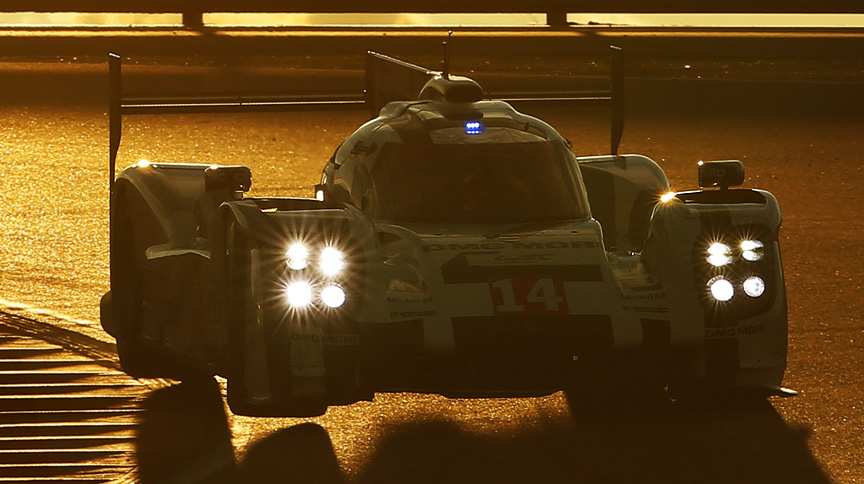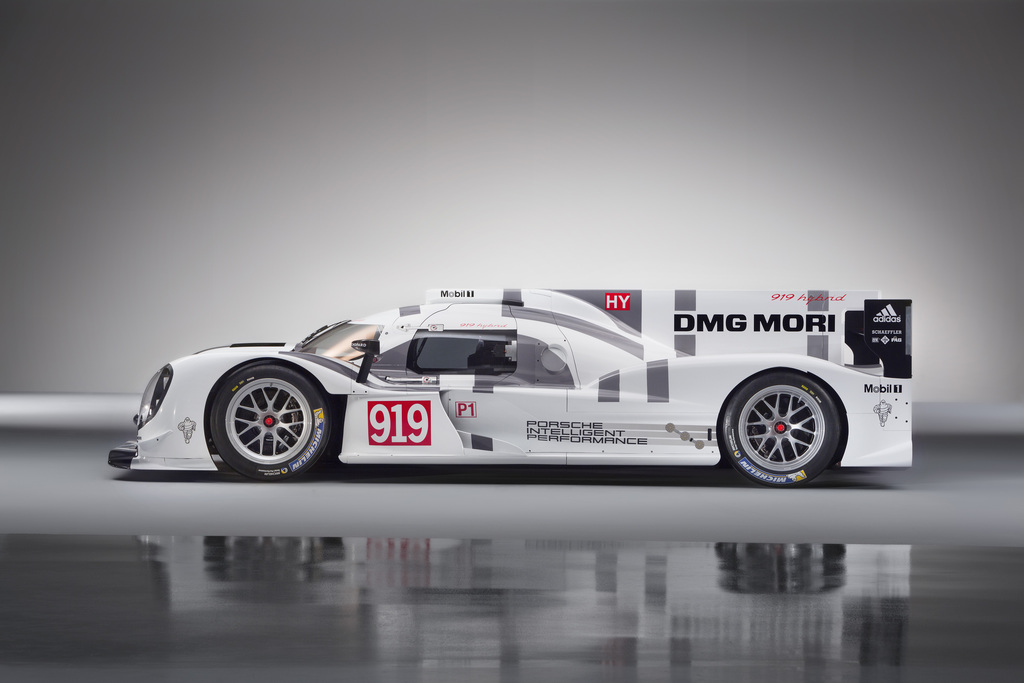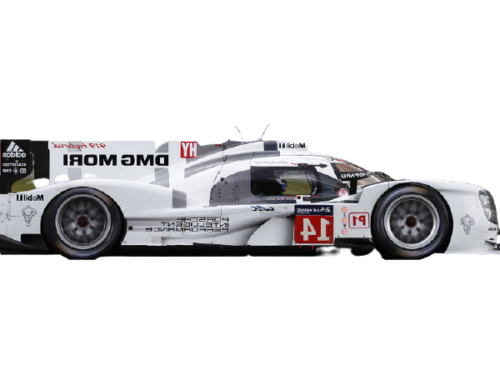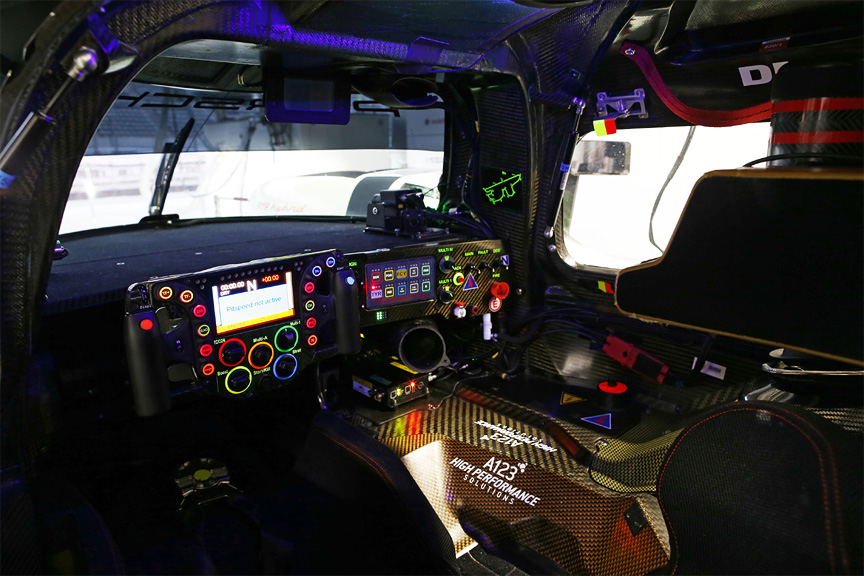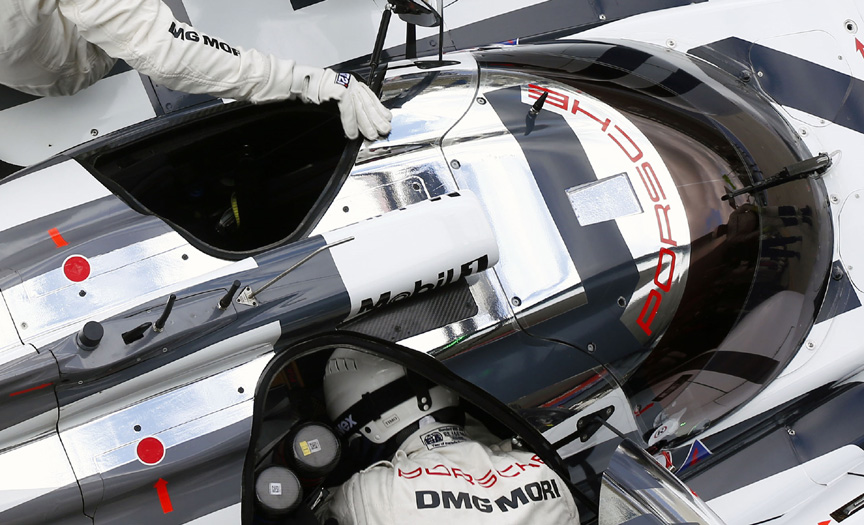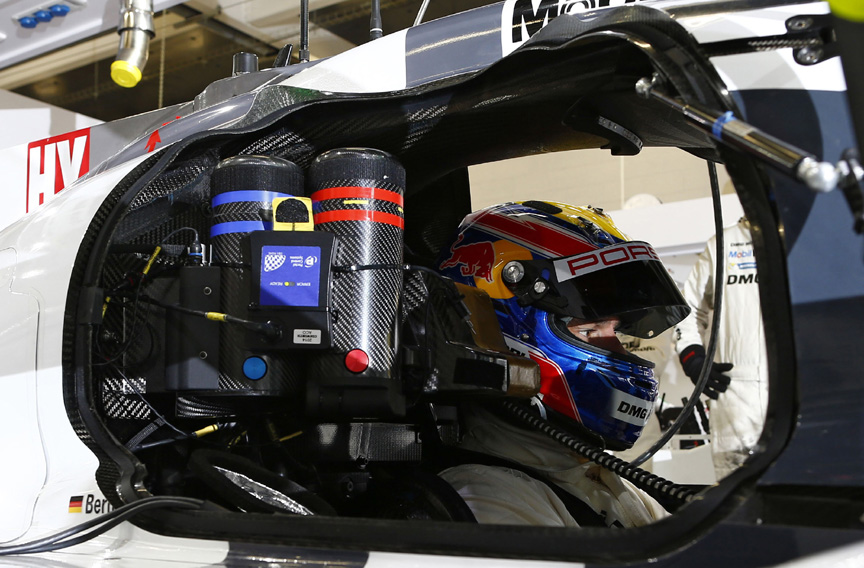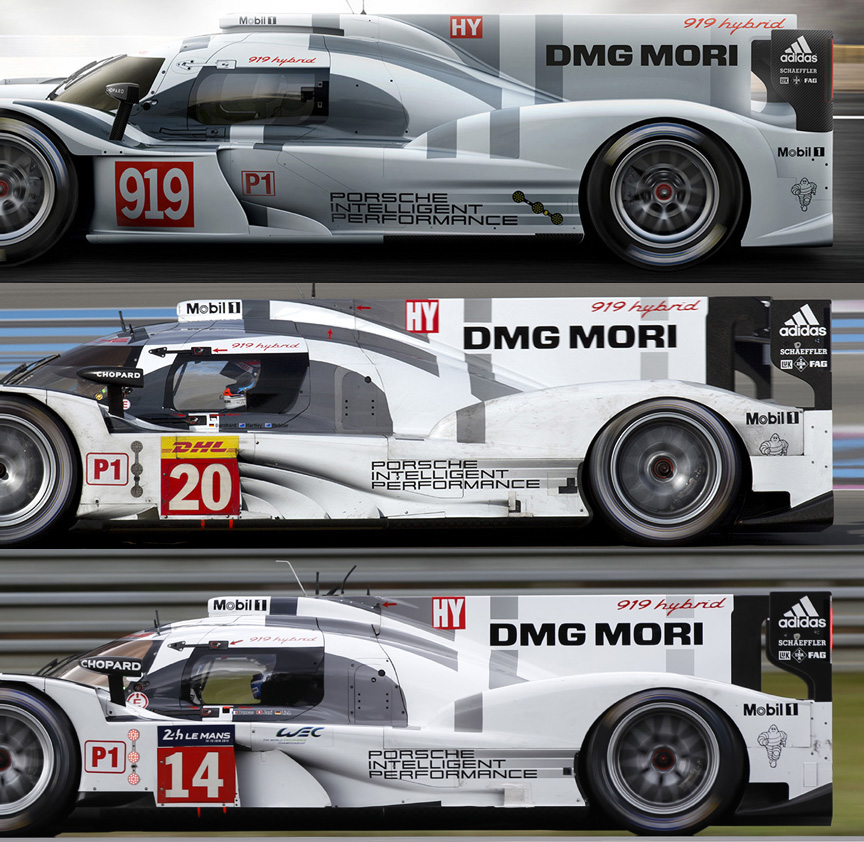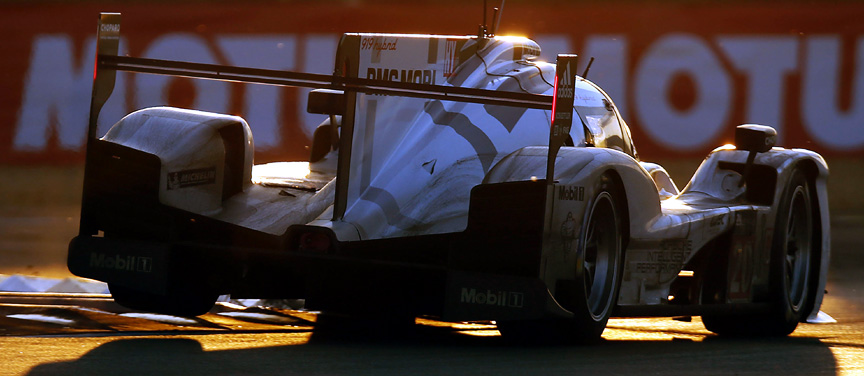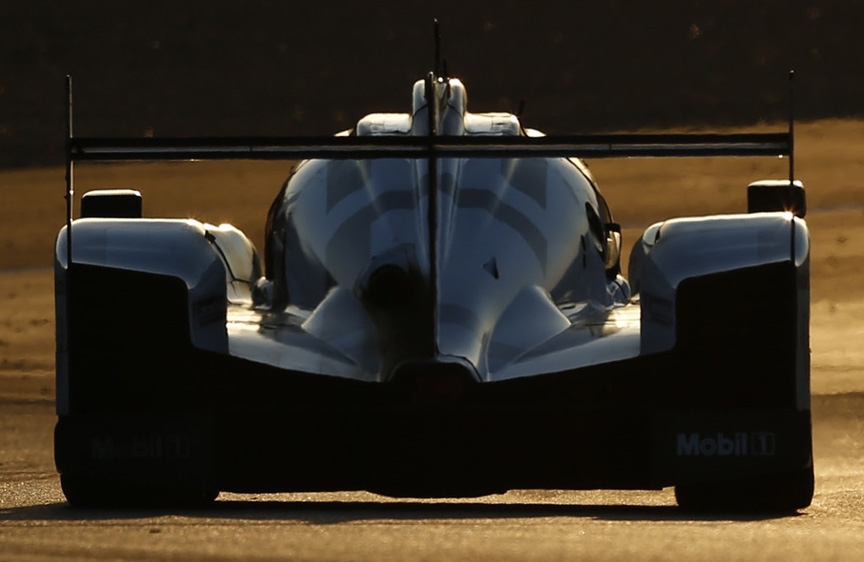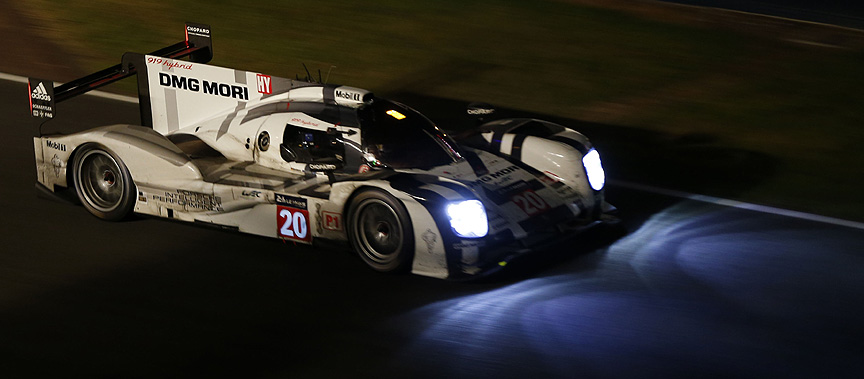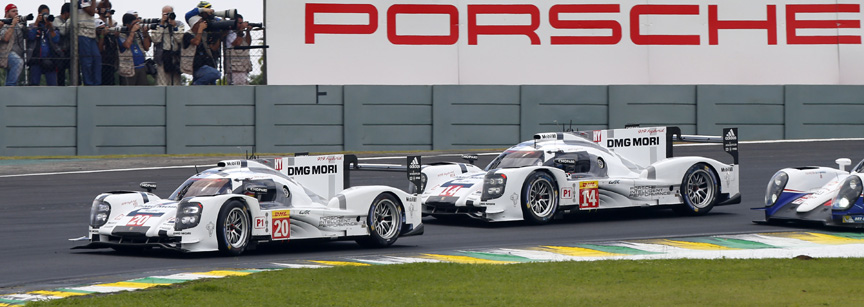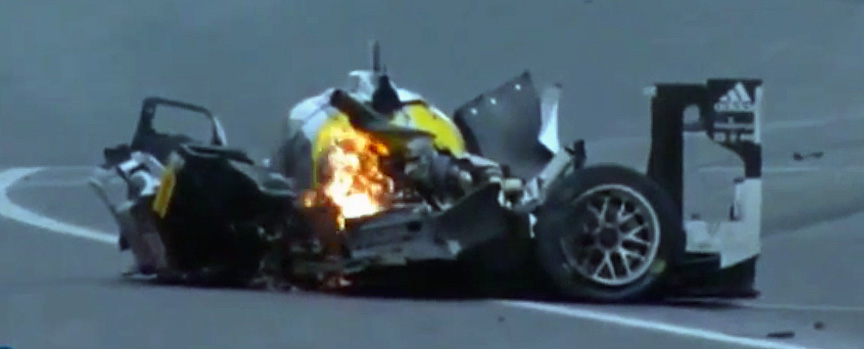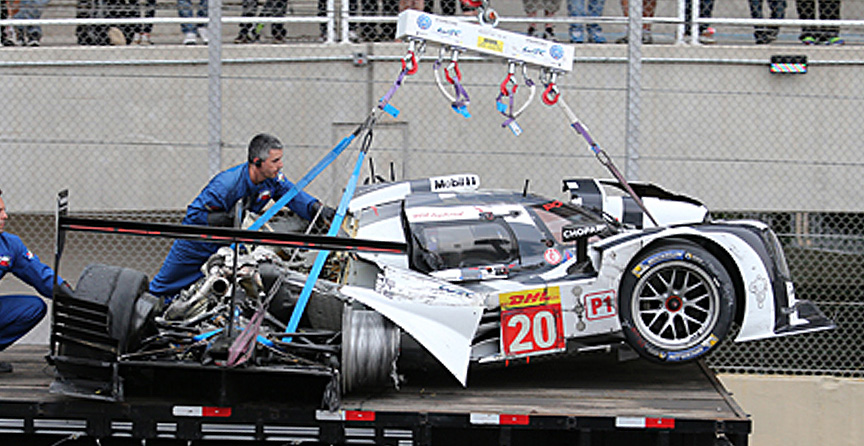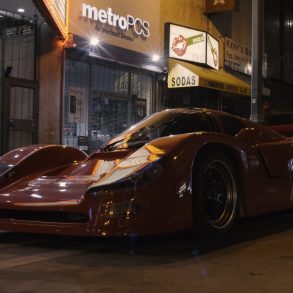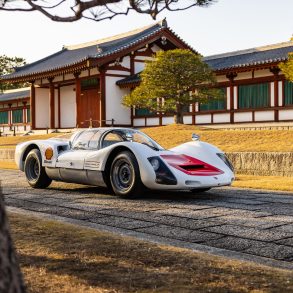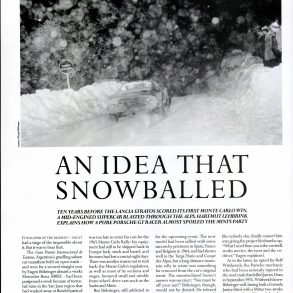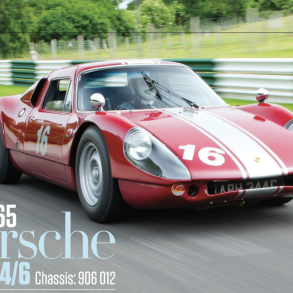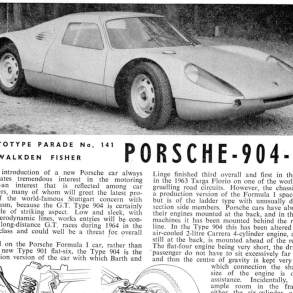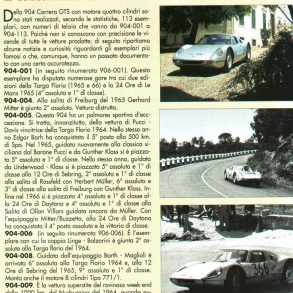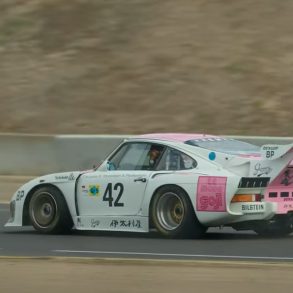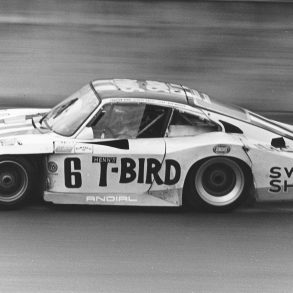2014 Porsche 919 Hybrid (9R9-2014)
Premiere: 2014 March 4 at Geneva motor show press day
The Porsche LMP1-H (Le Mans Prototype Class 1, Hybrid) race car featured a hybrid system that consisted of a turbocharged 2.0V4 petrol engine at the rear axle and an electric motor at the front axle. The electric motor/generator unit (MGU) collected the energy from the front axle under braking and the AER exhaust energy recovery system operated on the exhaust gas – a separate turbocharger ran an alternator. The 2-litre engine sounds like a very small one, but the air flow into the engine was not restricted and up to 4 bar/58 PSI turbo boost pressure was allowed. By the new rules, the instant fuel consumption was limited and therefore the 2-litre engine was the effective choice. The Energy Recovery System (ERS) stored the energy in a battery until the driver activated the electric motor on the front axle.
The 919 Hybrid Basics
- Internal combustion engine (drives rear wheels): 2.0V4 turbo *390 kW/530 PS (officially >370 kW/500 PS), 9000 rpm max.
- Electric motor (drives front wheels): *221 kW/300 PS (officially >185 kW/250 PS)
- Peak system power: *610 kW/830 PS
- Gearbox: 7-speed, hydraulically operated
- Wheels and tyres: 14×18 BBS forged magnesium wheels with 310/710-18 Michelin tires front and rear
- Weight without fuel: 870 kg / 1918 lb by the regulations
* estimation by Stuttcars.com, no official data available
Everything new for the Le Mans in 2014
Until 2013 the LMP1 powertrain main concept was based on performance and from 2014 it was based on efficiency. Instant fuel flow was controlled, but not global amount of fuel which meant no strategy in fuel economy. Manufacturers (LMP1-Hybrid) and privateers (LMP1-Light) competed in the same LMP1 category for overall win of races. Manufacturers entered Manufacturer’s FIA World Endurance Championship and privateers entered FIA Endurance Trophy for LMP1 Privateers. The FIA World Endurance Championship (WEC) rules for LMP1-H limited the amount of fuel in accordance to the used electrical boost – the more electrical boost you use, the less fuel you are allowed to use. There were four classes with electric boost levels ranging from 2 to 8 mega joules (MJ). The 919 Hybrid was designed for the 8 MJ class, but finally homologated for the 6 MJ class. The minimum allowed weight of 870 kg for the car meant that together with the heavy electrical components, small and lightweight internal combustion engine was used together with the lightweight carbon fibre chassis and body.
Allowed fuel consumption versus used electric energy – values for Le Mans circuit
| Electric energy used per lap | Petrol flow limited to | Diesel flow limited to | |
|---|---|---|---|
| LMP1-Hybrid | 2 MJ 4 MJ 6 MJ 8 MJ |
93.0 kg/h 5.04 L/lap 90.5 kg/h 4.88 L/lap 87.9 kg/h 4.72 L/lap 87.3 kg/h 4.64 L/lap |
83.3 kg/h 4.07 L/lap 81.0 kg/h 3.95 L/lap 78.3 kg/h 3.82 L/lap 76.2 kg/h 3.69 L/lap |
| LMP1-Light (no ERS) | 95.6 kg/h | 83.4 kg/h |
2014 LMP1 regulations in brief
- LMP1 car is a closed racing car with no production minimum
- Category for manufacturers: Le Mans Prototype 1 Hybrid (LM P1-H) – cars with Energy Recovery Systems (ERS)
- Category for privateers: Le Mans Prototype 1 Light (LM P1-L) – cars without ERS
- Engine cubic capacity is free for P1-H cars and must not exceed 5500 cm3 for P1-L cars. Fuel mass flow must not exceed a limit. Ratio of supercharging pressure must not exceed 4.0.
- Maximum dimensions: 4650 x 1900 x 1050 mm, front overhang limited to 1000 mm, rear overhang to 750 mm. Any sprung part of the car must be situated more than 50 mm above the reference surface.
- Minimum weight of the car with no driver and no fuel: 870 kg for LMP1-H and 850 kg for LMP1-L
- Fuel capacity carried on-board: petrol cars 66.9 L, diesel cars 54.8 L
- Any active system is forbidden: chassis control, automatic transmissions (like for example double-clutch gearbox), final drive differential system (mechanical lock is not active system and is allowed), shock absorbers, suspension or ride height adjustment, four wheel steering, ABS etc. A traction control system operating on the power unit is authorized.
- Any system operated automatically or controlled by the driver to modify airflow when the car is in motion is forbidden. Blown diffuser is forbidden.
- Wheels: 1-piece homogeneous metal, maximum size 13×18″, minimum weight 7.5 kg
- The FIA mandatory logging sensors are lap trigger, fuel flow meters, boost pressure, fuel temperature, fuel pressure before fuel flow meter, oil catch-tank level sensor, cockpit internal temperature, command current and voltage of each Motor Generator Unit (MGU).
- The ventilation system must control the temperature in the cockpit with predetermined values.
- The door hinges and locks must be designed to allow a quick release of the entire door in case of emergency. The cockpit must be designed so as to allow the driver wearing his complete driving equipment, being seated with the seat belts fastened and the steering wheel in place to get out in 7 seconds from the driver’s side or in 9 seconds from the passenger’s side. The windscreen must be removable by the marshals using the hex key.
Facts and figures
- In qualifying every driver must run at least 5 laps in the dark. While WEC rules call for averaging the 2 fastest laps of 2 drivers (i.e. the mean of 4 lap times), the classic Le Mans method is to simply take the fastest lap driven with the car.
- For the Le Mans night the sun sets on Saturday at 9:55 pm, and it rises on Sunday at 5:53 am.
- In normal racing mode (without any safety car periods), the Porsche 919 Hybrid must refuel every 13 to 14 laps.
- Refuelling and wheel changing may only be made sequentially, not at the same time. Only two mechanics may work simultaneously when wheel changing.
- Drivers are normally only changed when new tyres are needed.
- 2-4 fuel stops between every new set of tyres (Michelin)
- During the race, no driver may drive for more than 4 hours within a 6-hour period. No driver may drive for more than 14 of the 24 hours.
- The equipment taken to the track – in addition to the two 919 – includes a spare chassis, 6 engines, 5 front gearboxes, 5 rear gearboxes, 6 front wings and 6 rear wings, 80 rims, over 100 radios and headsets.
- Twice as many points are awarded at Le Mans than in the other seven races for the World Endurance Championship (WEC) that are each six hours long.
- The core team of Porsche for LMP1 racing at the race circuit in Le Mans consists of 86 team members (engineers, mechanics, team management). Add to that personnel from communication and marketing, sponsoring and driver support.
2013 Porsche 919 Hybrid Prototype
The 919 front axle including the KERS, the electric motor, and the battery was first installed for testing purposes in a 911 GT3 prototype.
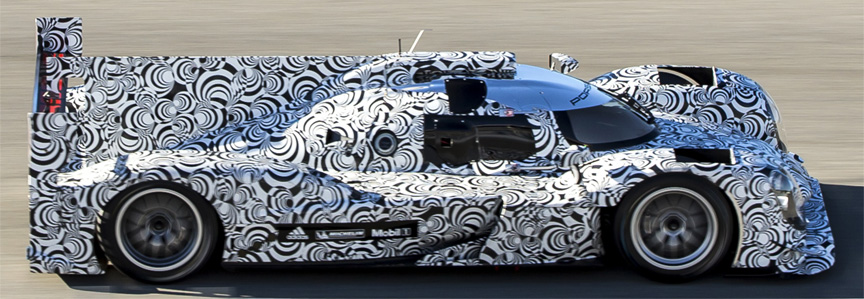
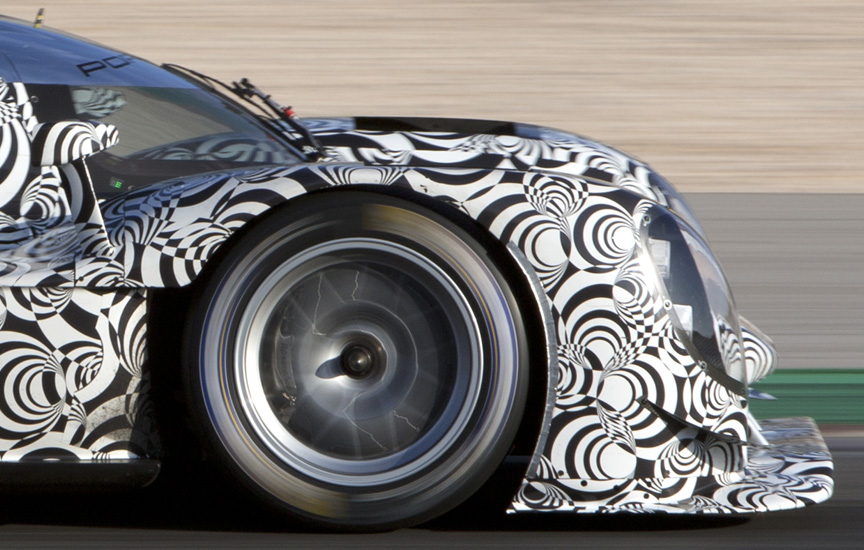
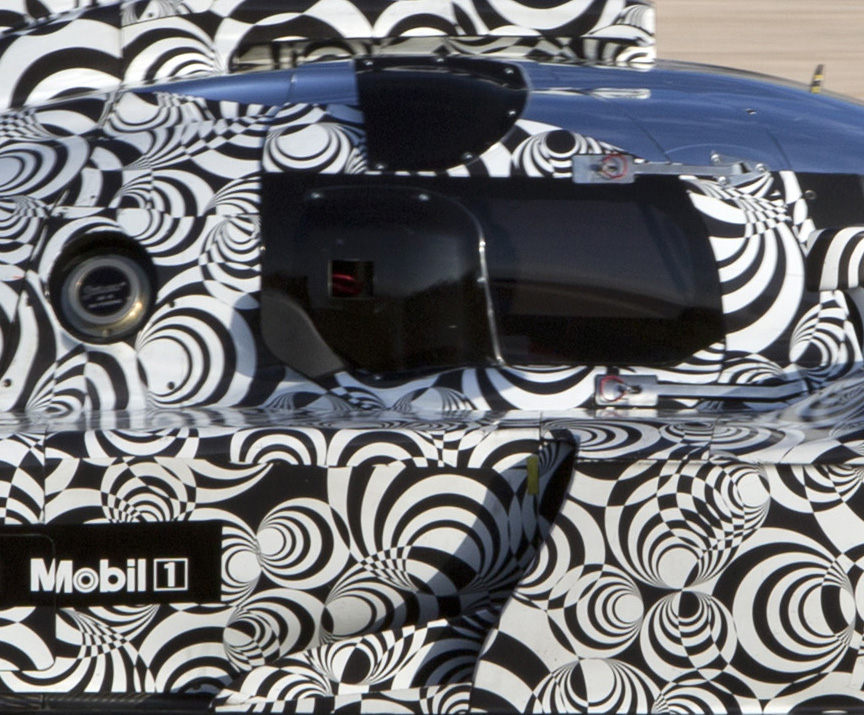
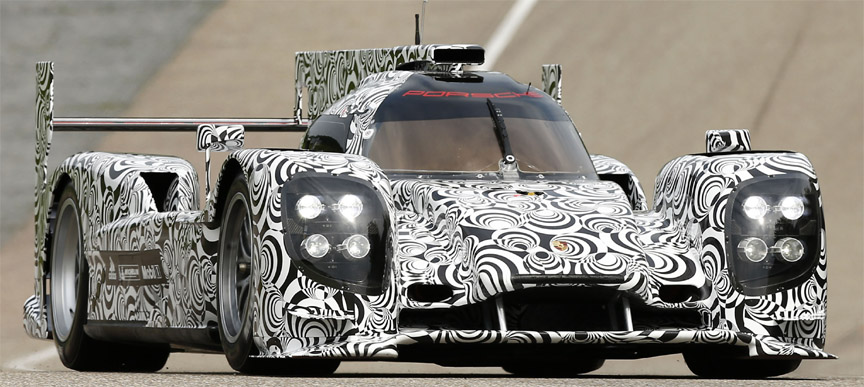
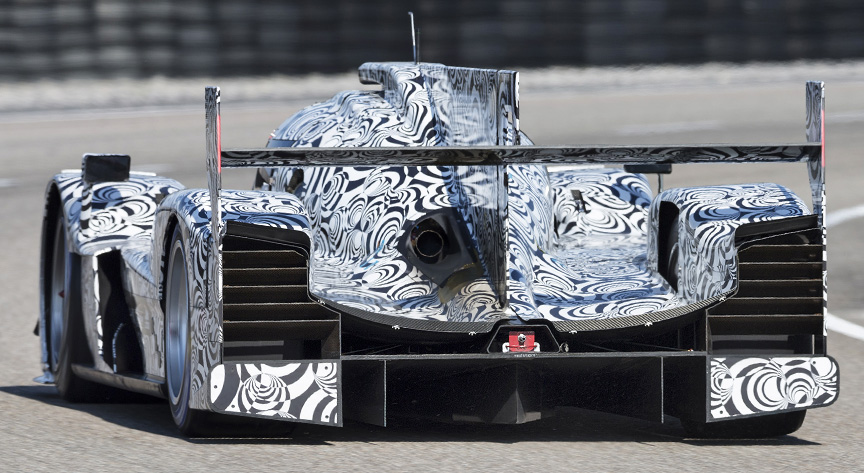
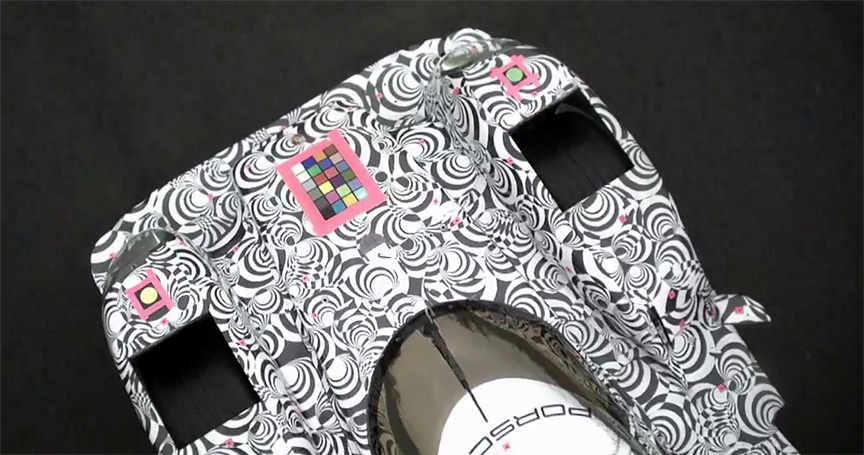
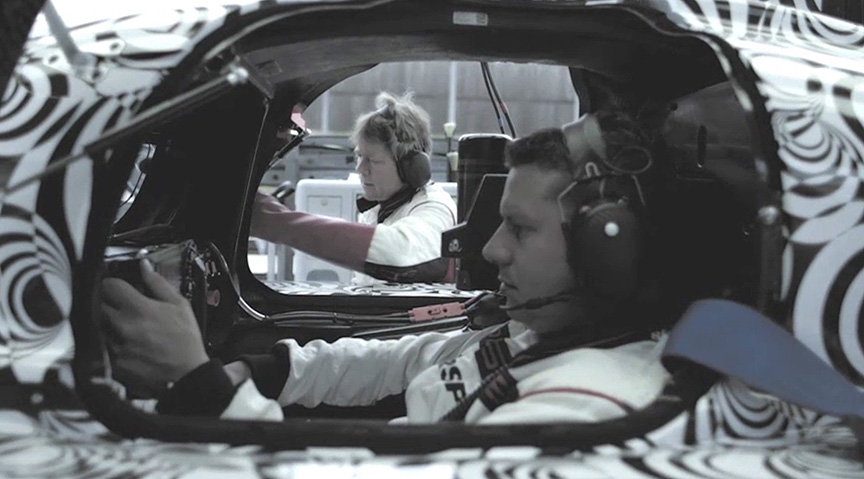

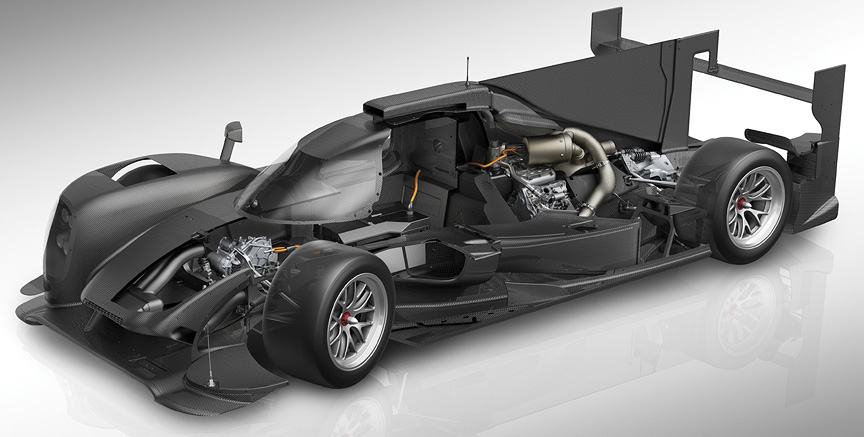
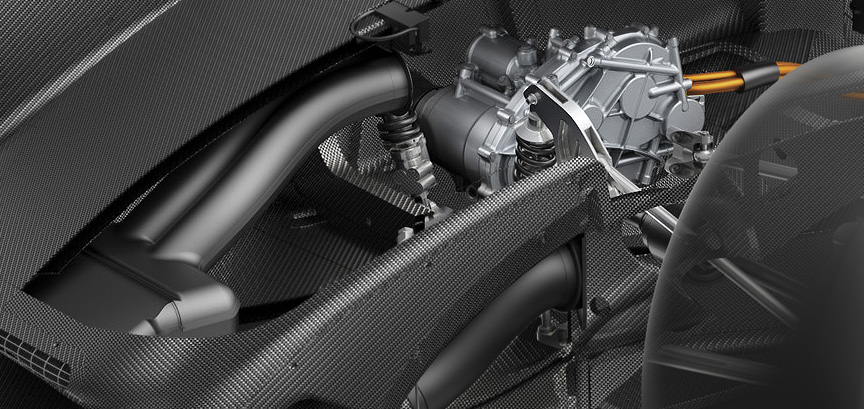
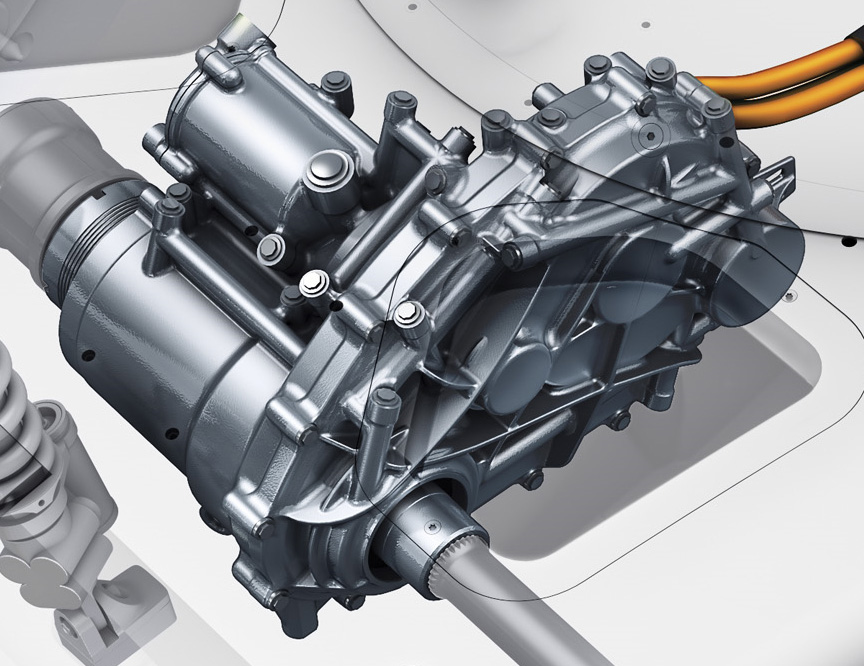
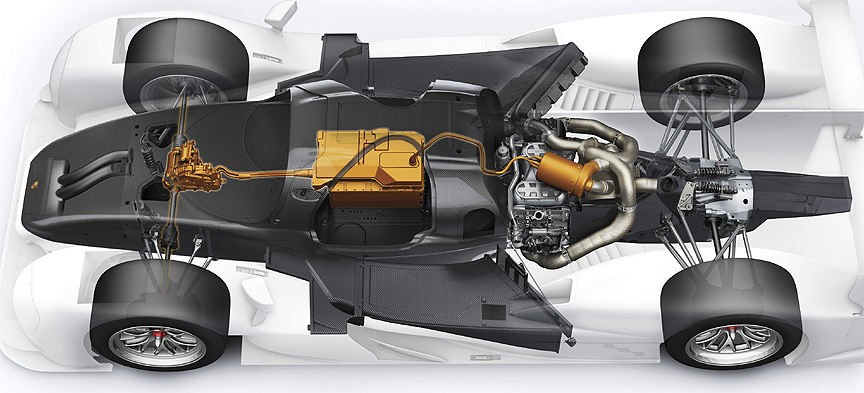
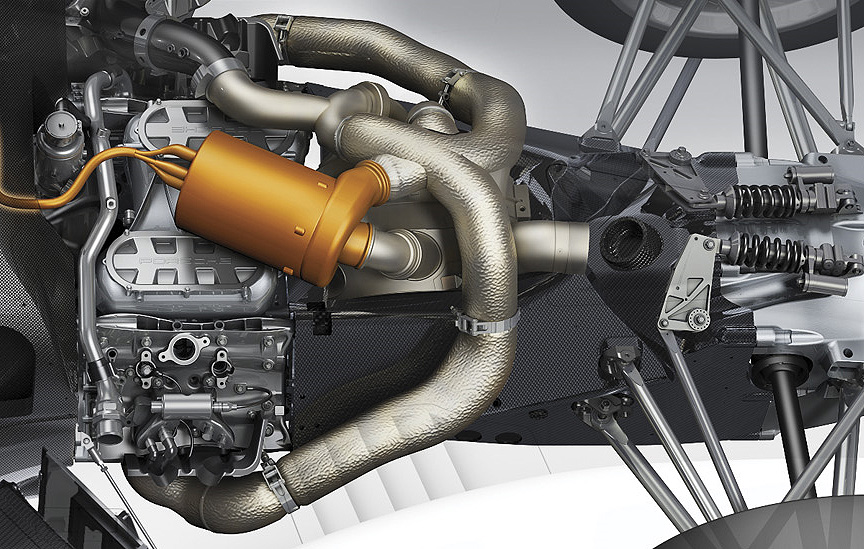
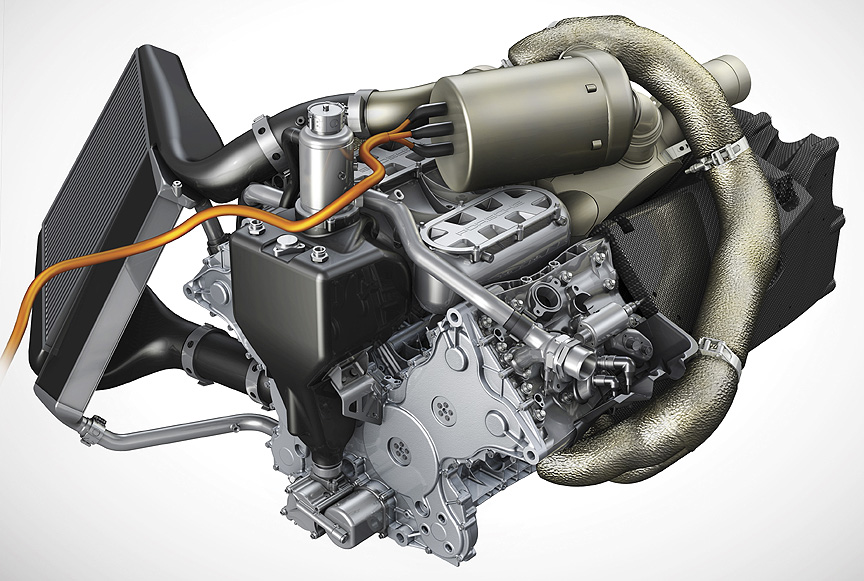
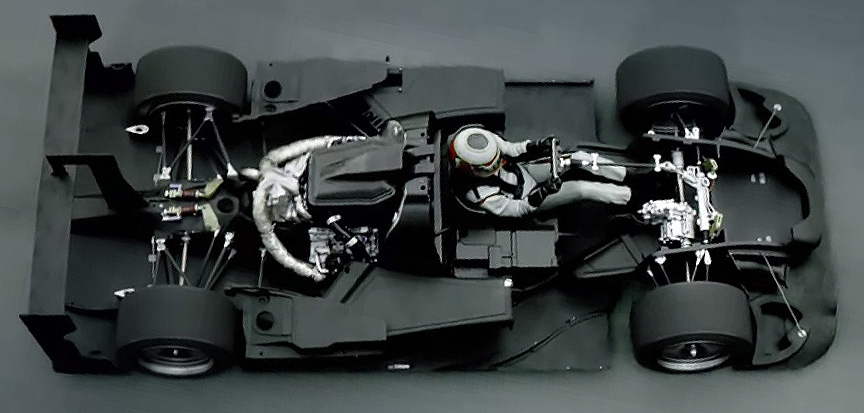


2014 Geneva Motor Show
The 919 presented at the Geneva Motor Show on March 4, 2014, was a 2013 prototype in 2014 racing livery, not the actual 2014 racing car. The real 2014 cars were under fine tuning and the Geneva show car was a repainted early prototype that in 2013 had the black and white piebald livery.
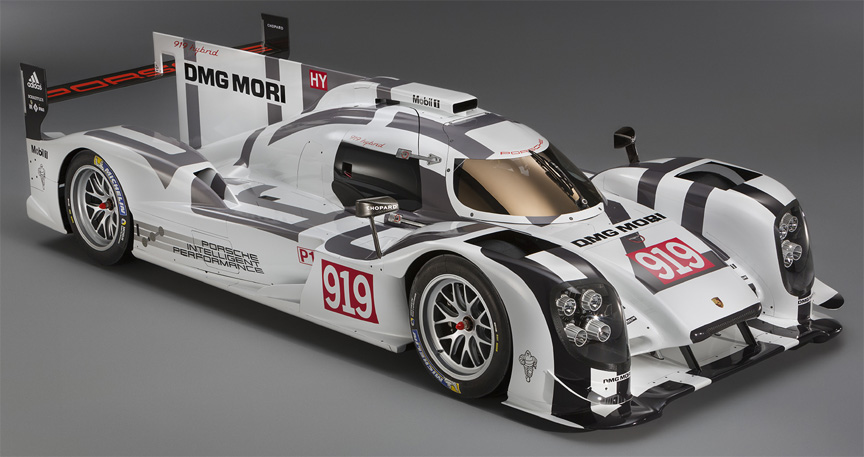
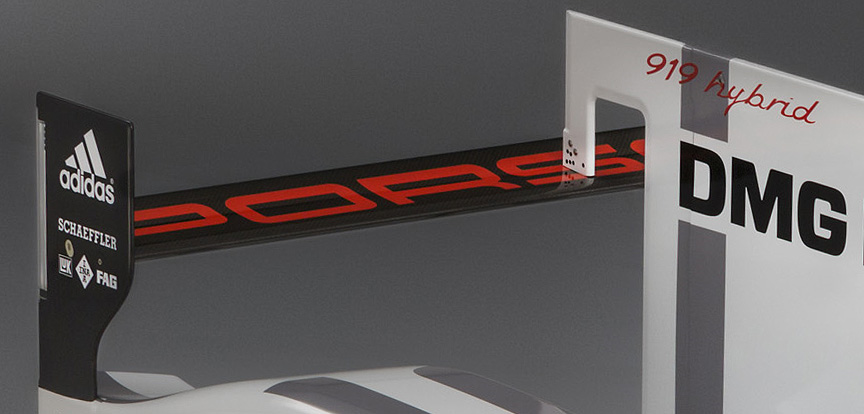
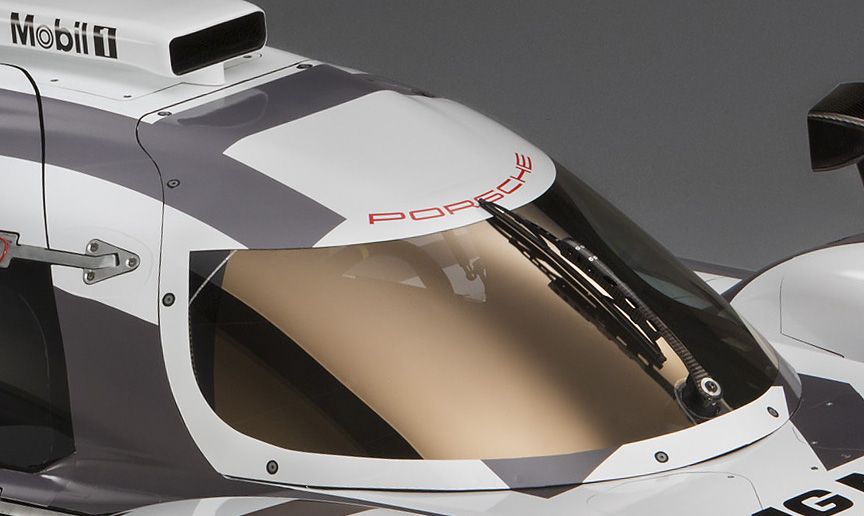
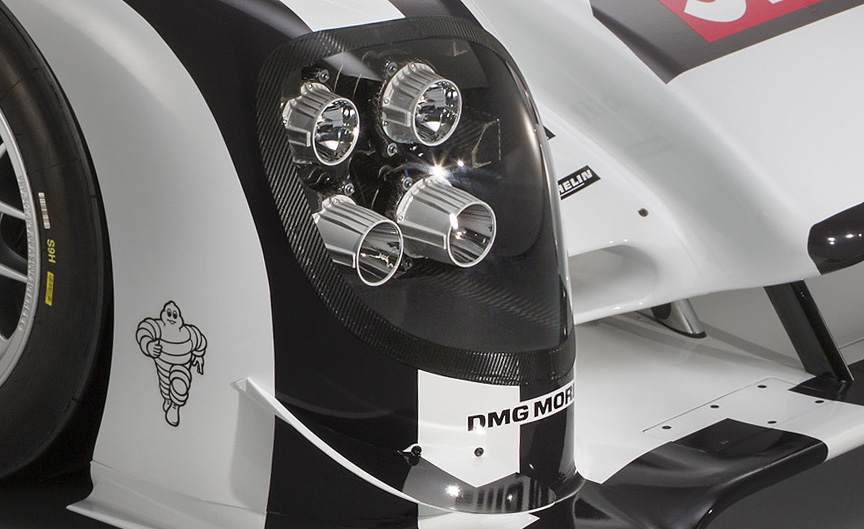
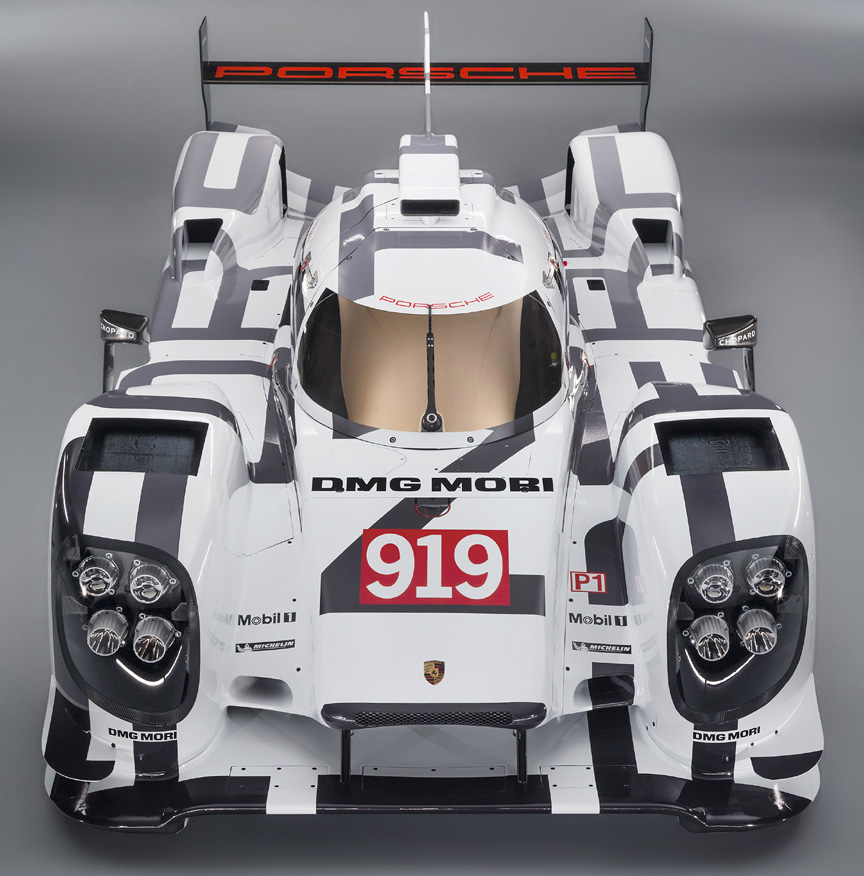
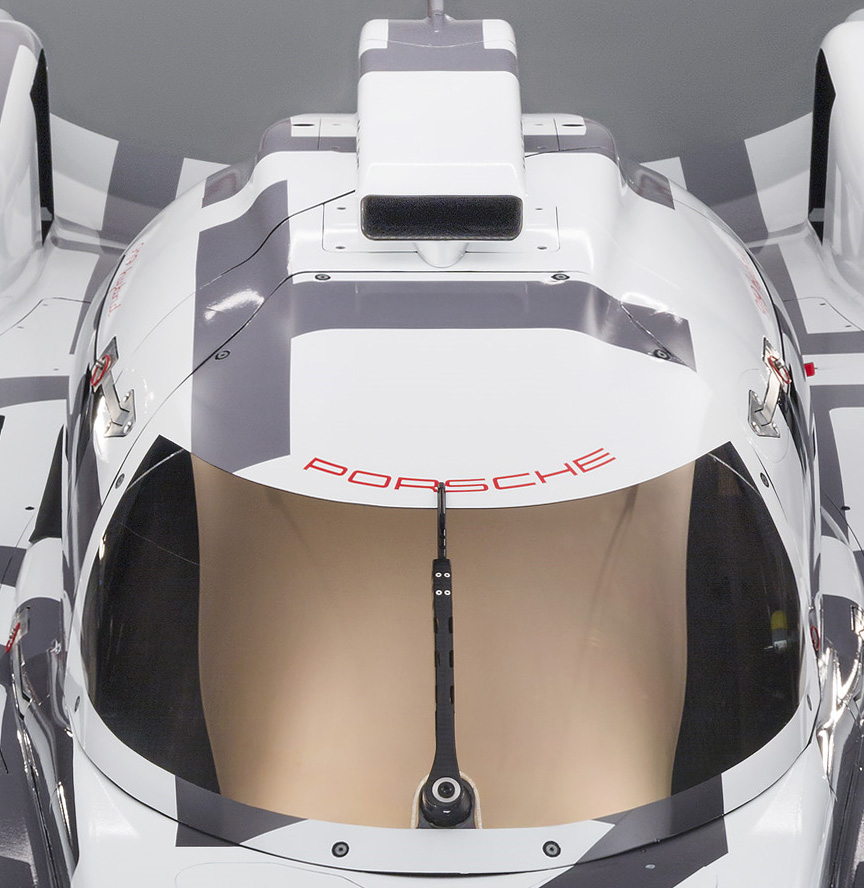
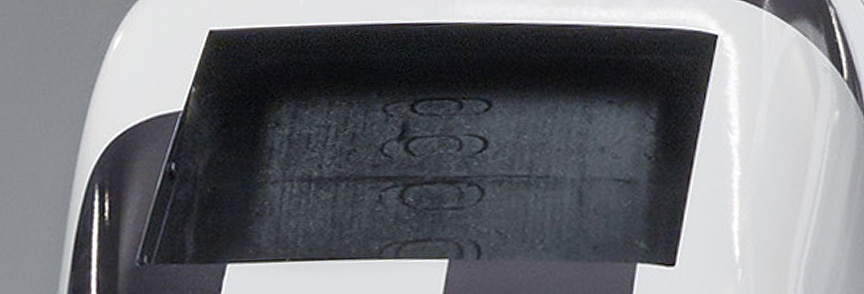
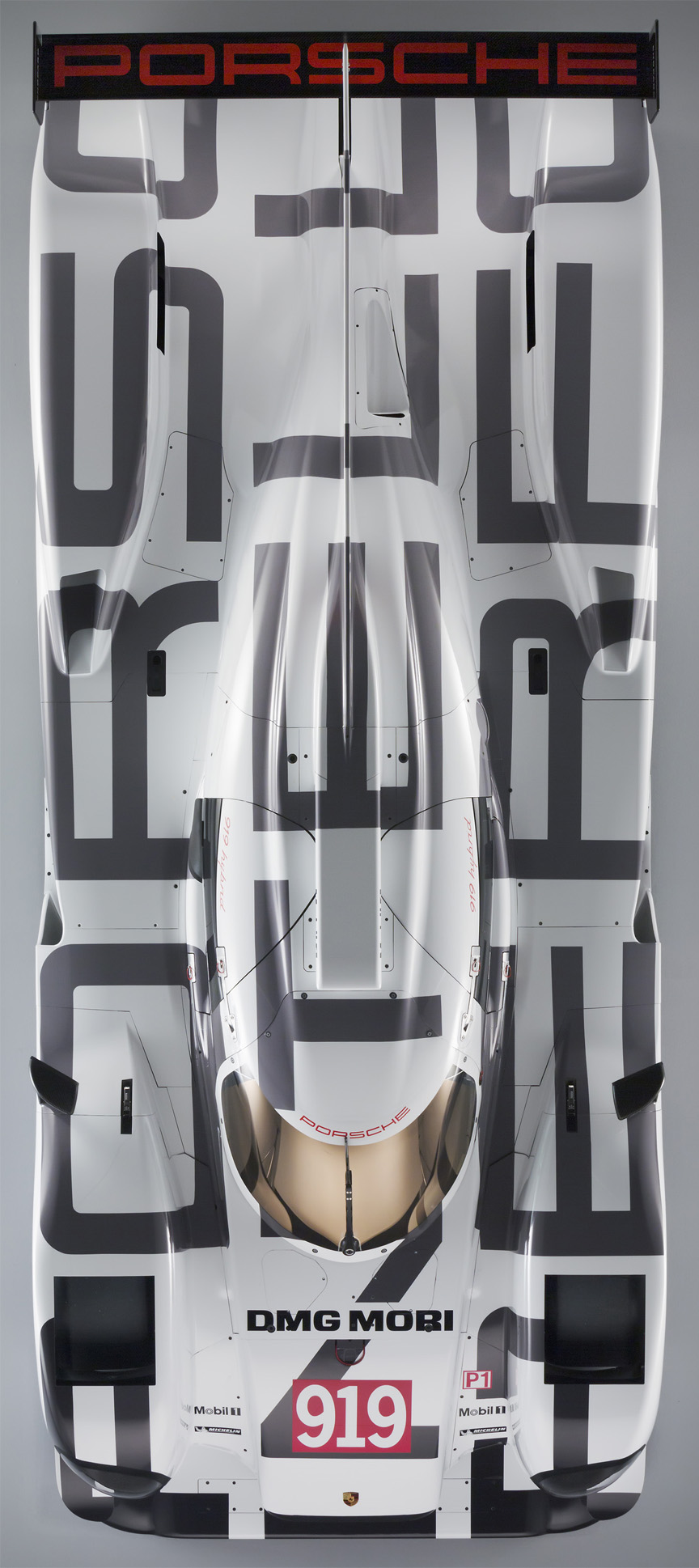
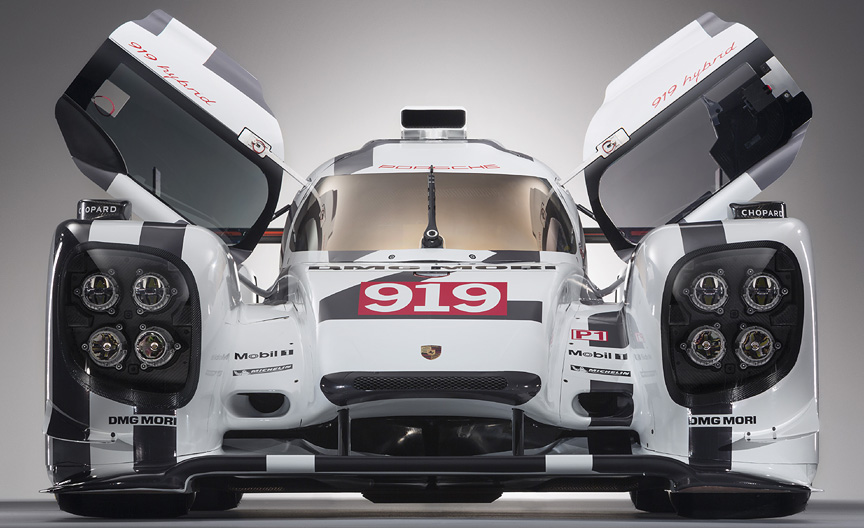
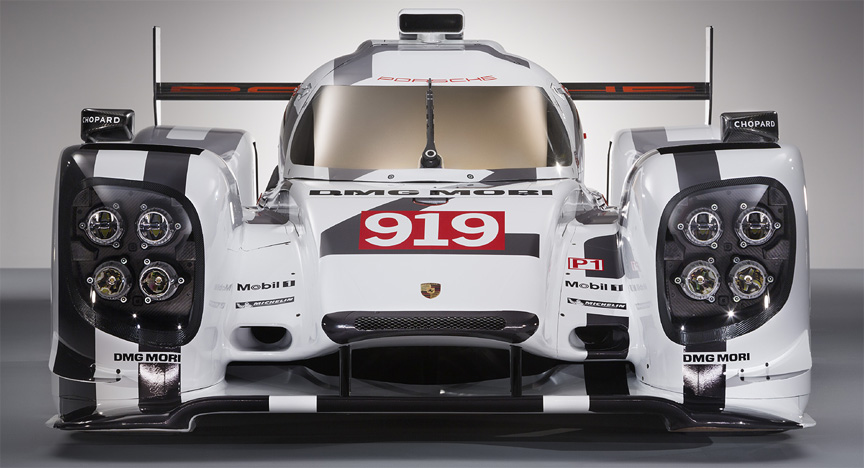
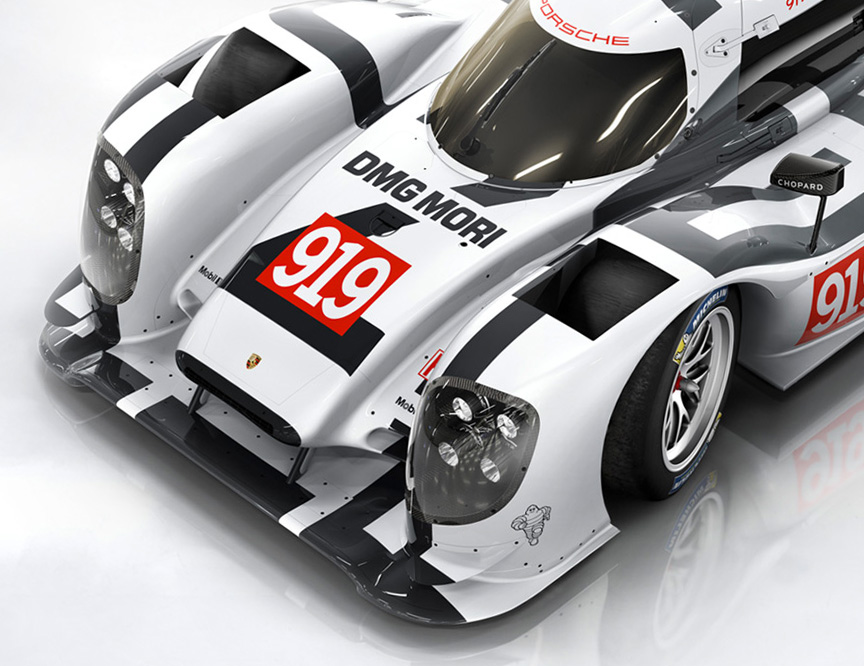

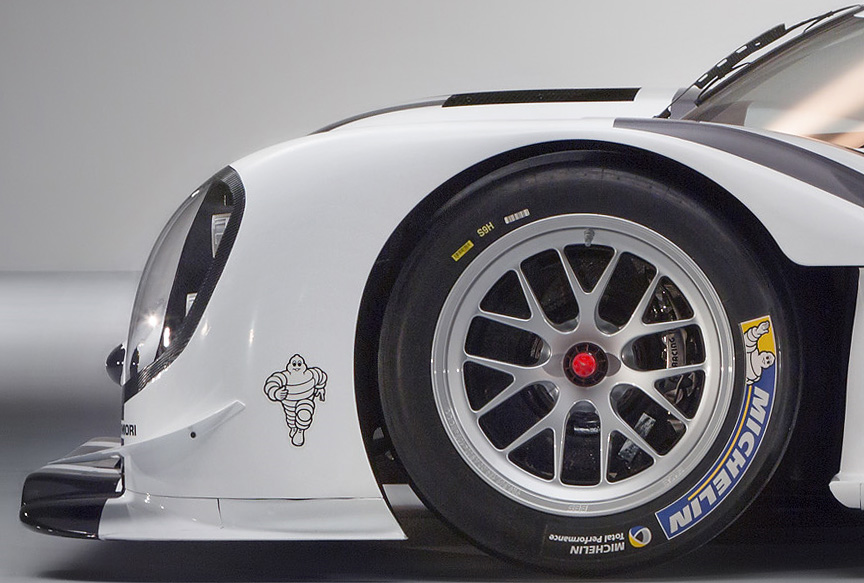
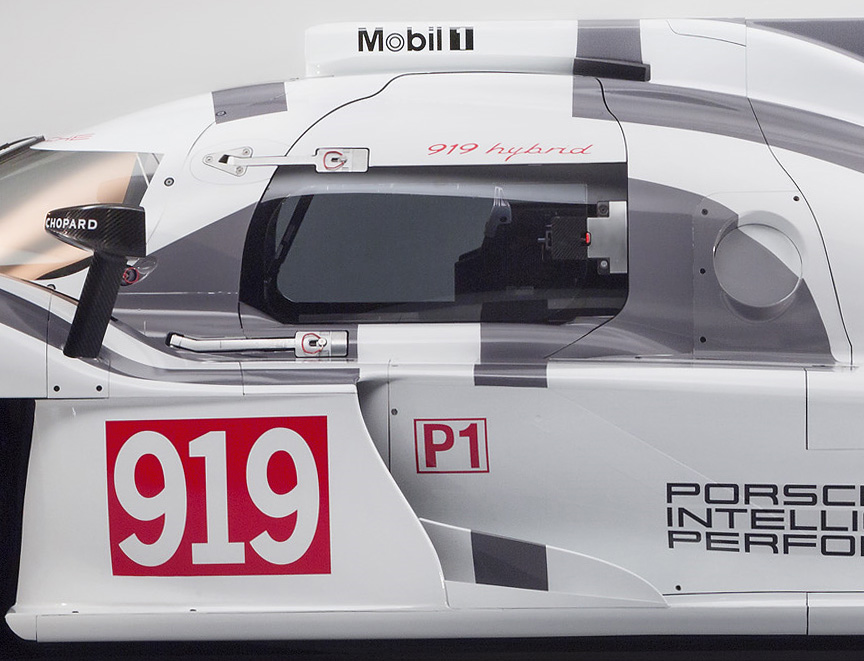
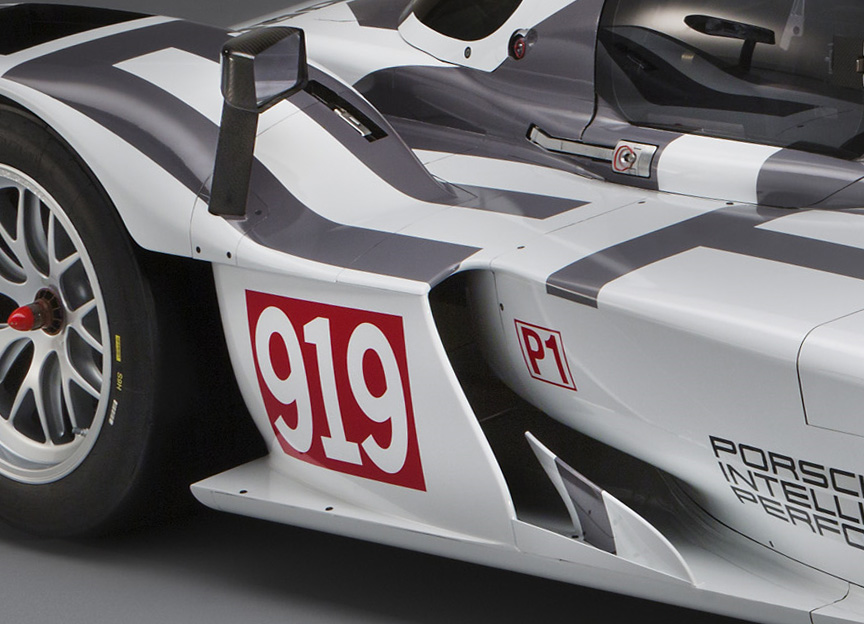
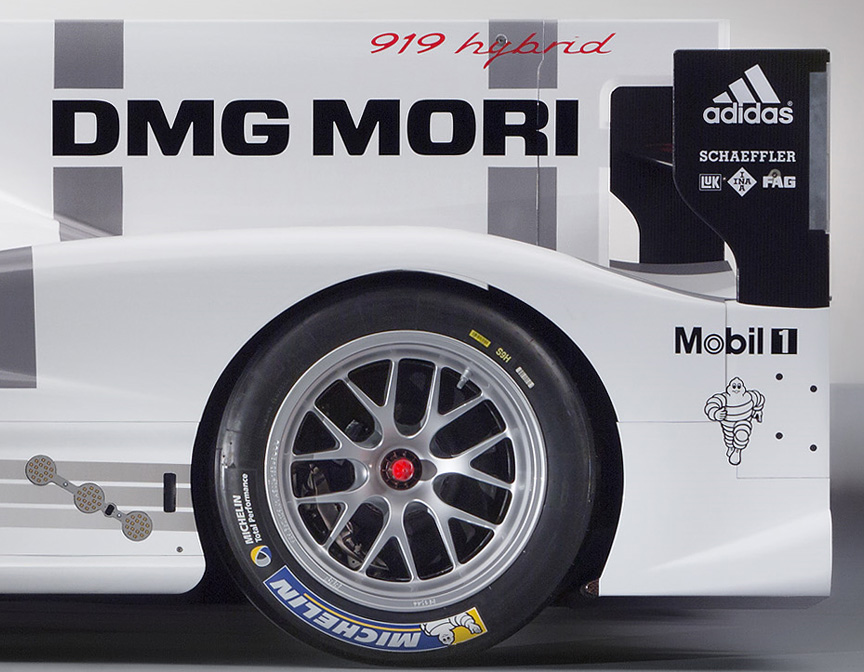
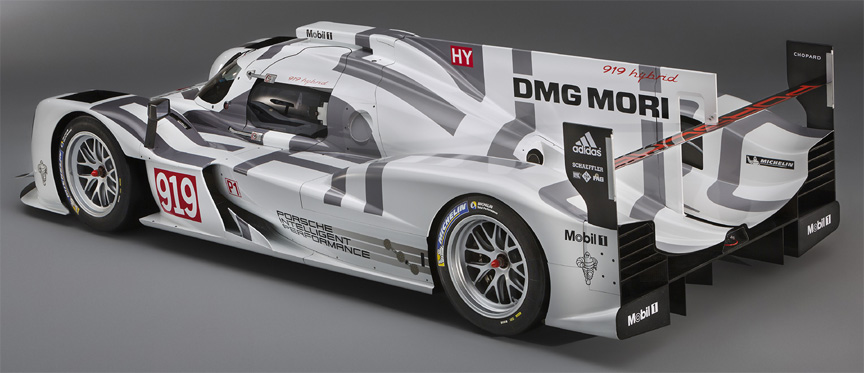
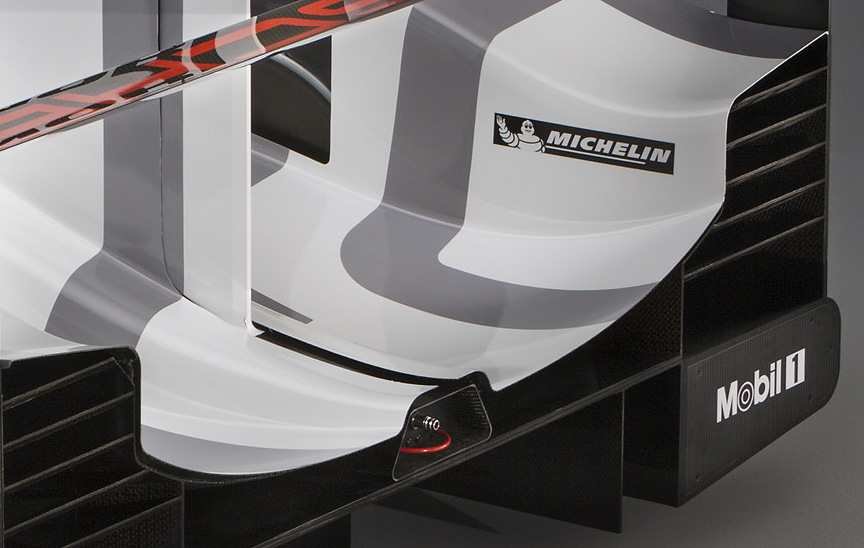
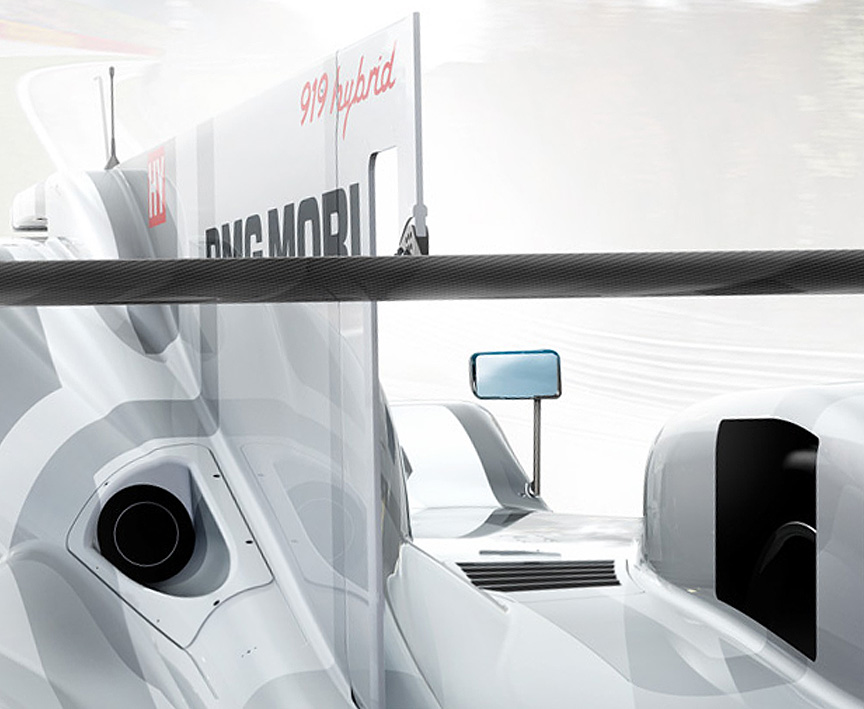
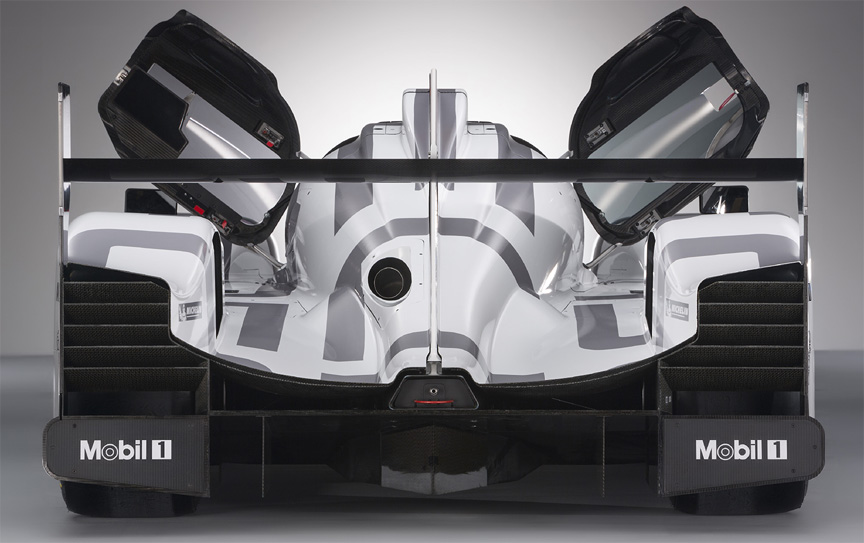
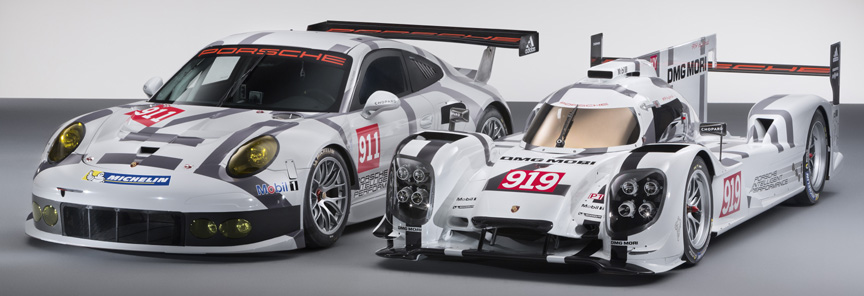
2014 March 24-26 tests and March 27-28 WEC Prologue at Paul Ricard HTTT (High Tech Test Track) in Le Castellet, France
Compared to the 919 revealed three weeks before at the Geneva Motor Show, the test cars in Le Castellet were already the real 2014 racing versions. In Castellet, the two 919 together covered 4,756 km (821 laps) in tests and 3,556 km (614 laps) in WEC Prologue. The 919 hybrid driven by Brendon Hartley did the quickest lap in 1:41.289. The second fastest was an Audi with 1:42.073. So, the speed was there and the reliability had to be ensured.
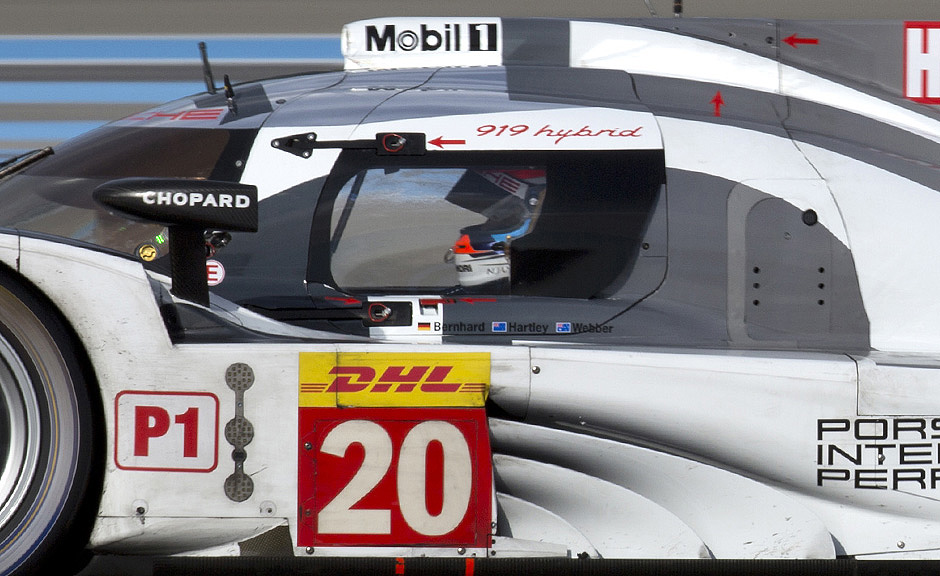
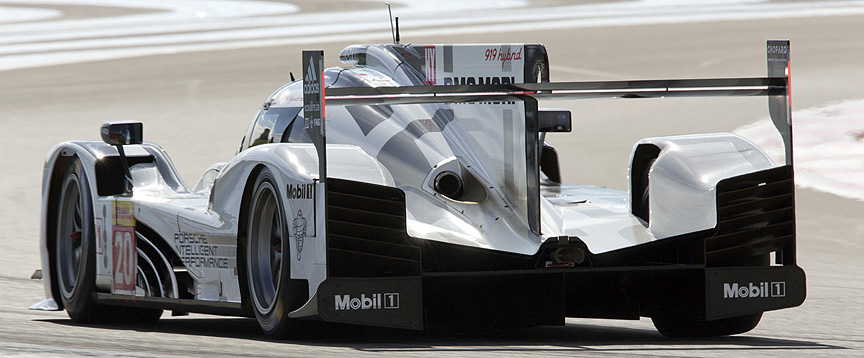
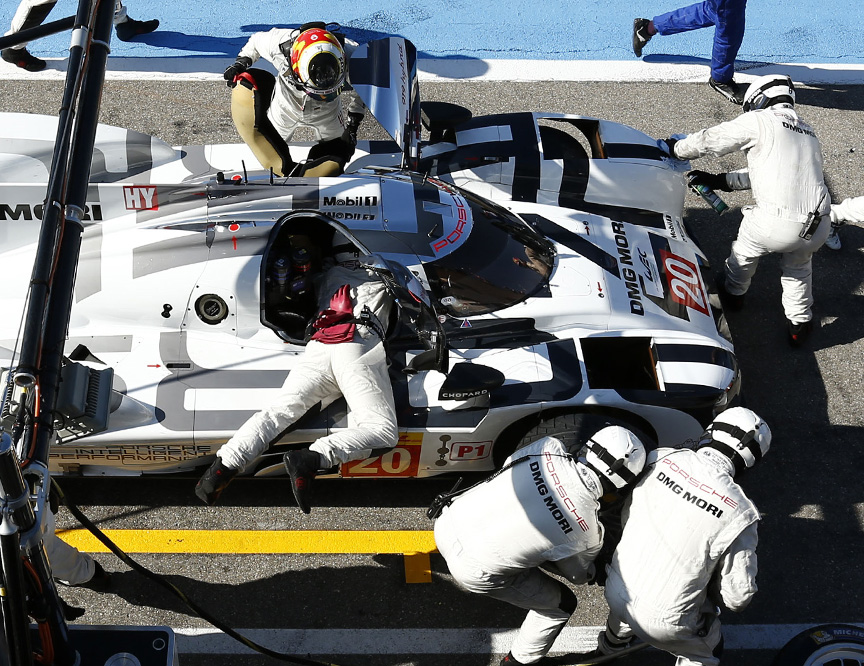
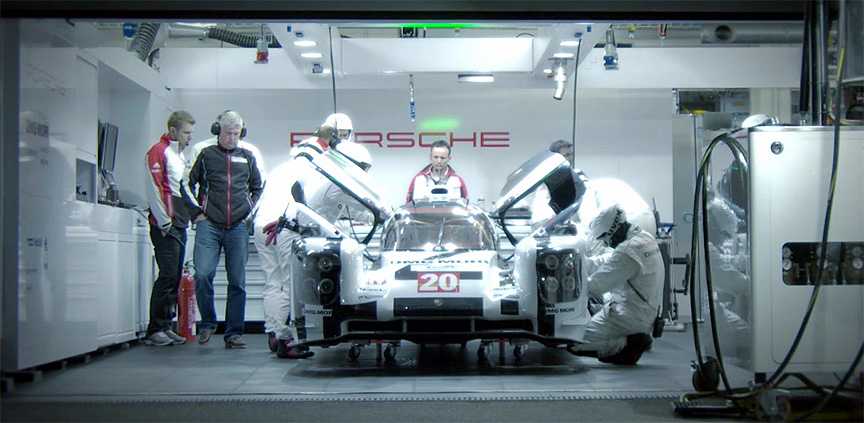
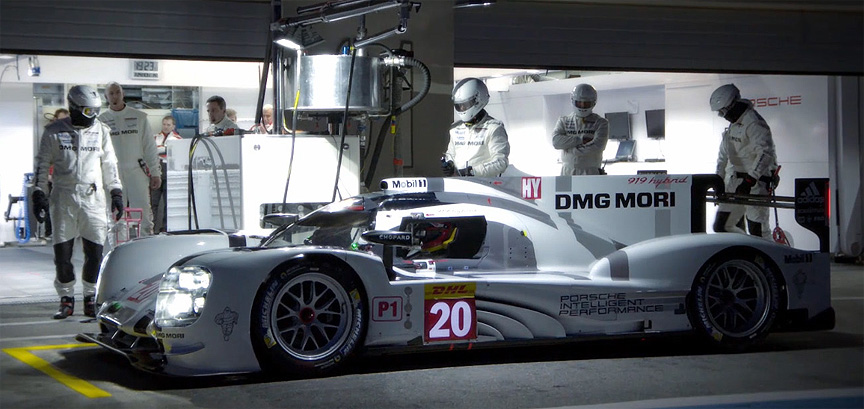
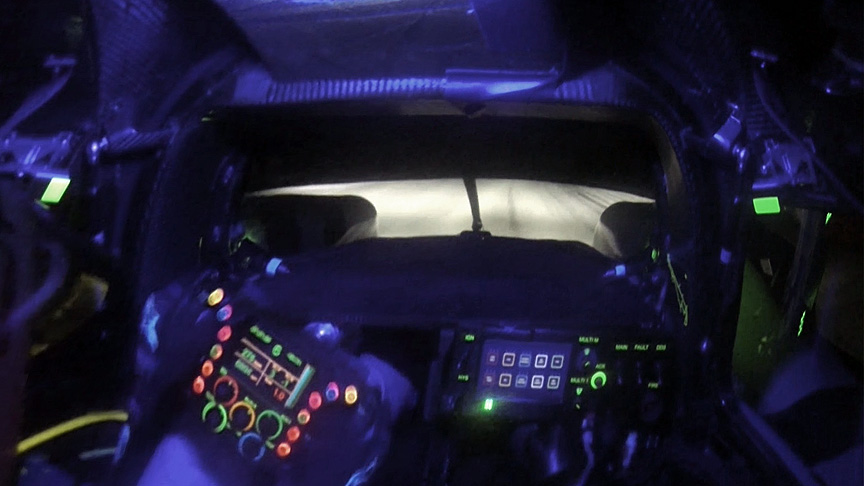

The steering wheel
[From press release] The drivers of the Class 1 Le Mans prototypes in the FIA World Endurance Championship have a computer in their hands. They operate 24 buttons and switches on the front as well as six paddles on the reverse side to control the most complex racing car built by Porsche to date.
Although it is called a steering wheel, it is not round but a flat rectangle. The shape is due to the space required during driver changes. Tall drivers such as Mark Webber or Brendon Hartley, in particular, would otherwise have difficulties in accommodating their long legs quickly. There is a large display in the centre, which displays a multitude of information to the driver. This includes the speed, what gear is engaged, the currently selected motor management, and the charge status of the lithium ion battery, i.e. how much electrical energy is available to be called up to drive the front axle. The electric motor on the front axle supplements the turbo charged two litre, four cylinder combustion motor, which drives the rear wheels. The control button at the top left (02) is used to select the displayed information, while the drivers use the control button in the right grip handle (14) to dim down the display brightness at night. The identical control button in the left grip handle (04) is for the volume of the pit radio, and the fourth rotary-type control at the top right varies the interval timing of the windscreen wiper (16).
The buttons and switches on the steering wheel were carefully positioned in cooperation with the drivers, to facilitate reliable operation at racing pace. The most frequently used buttons are positioned along the top outside edge, so they are easily reached with the thumb. The blue button at the top right (17) which is almost always in use, is the headlamp flasher, used by the fast prototypes to warn the slower vehicles in the WEC field before they are lapped. When pushed once, it causes the headlamps to flash three times. In daylight, the drivers keep their thumb on it almost permanently, as naturally the headlamp signal is more difficult to perceive at that time.
The red button at the top left (01) is also highly frequented. It is used to demand electrical power from the battery, the so-called “boost”. The drivers can boost to pass but must be clever about rationing the power. The amount of energy per lap is specified. The yardstick is one lap in Le Mans, where six megajoules are available. The amounts are converted accordingly for shorter circuits. The amount of energy a driver uses in the middle of a lap to get free of the traffic will not be available at the end in the straightaways.
A bit further inside on the right and left are the plus (13) (15) and minus switches (03) (05) to adjust the front and rear traction control and to distribute the brake balance (06) (12) between the front and rear axle. These (yellow, blue and pink) are not used quite as frequently.
The orange buttons further down operate the drinking system on left (18) and put the transmission in neutral on right (24). The red button at the bottom left (19) is for the windscreen washer, the red one on the right side (23) activates the cruise control to restrict the speed in the pit lane.
At the top centre, there are the green buttons for radio communication on the left (07) as well as the OK button on the right (11). Drivers use the latter to confirm they have performed a setting change, which was requested from them via the pit radio. For these settings, they use the rotary switches, and usually only in the straightaways as they need to pull one hand out of the steering wheel grip for this purpose.
The two rotary switches called ‘Multi’ correspond with one another. The left one (09) is available for ABC settings, the right one (10) is number-based. Programmes for engine management or fuel management are designated by combinations such as A2 or B3. Three other rotary switches are available to pre-select the brake balance (08), set the traction control (20) for wet or dry conditions and the hybrid strategy (22).
To make the switches easier to recognise in the dark, their colours are fluorescent and respond to a black light lamp, which is situated above the driver’s helmet.
The steering wheel is made of carbon, the grip handles are covered in slip-resistant rubber. Thanks to the power steering system, drivers can steer the car without any difficulty, even with the relatively narrow grips. When reaching through the openings, their fingers touch six paddles on the reverse side of the steering wheel. The centre paddles are used for changing gears – pulling the right paddle is for upshifting, and pulling the left paddle is for downshifting. The lowermost paddles operate the clutch and their function is identical on either side. Depending on whether the driver just entered a right or left curve, he can decide which side is easier to operate. The paddle at the top left operates the boost; whether the drivers use this paddle or the button described on the front is purely a matter of preference. The drivers use the paddle at the top right to initiate manual energy recuperation. This feels like a slightly engaged hand brake and supplies the battery reservoir with electric energy gained from kinetic energy.
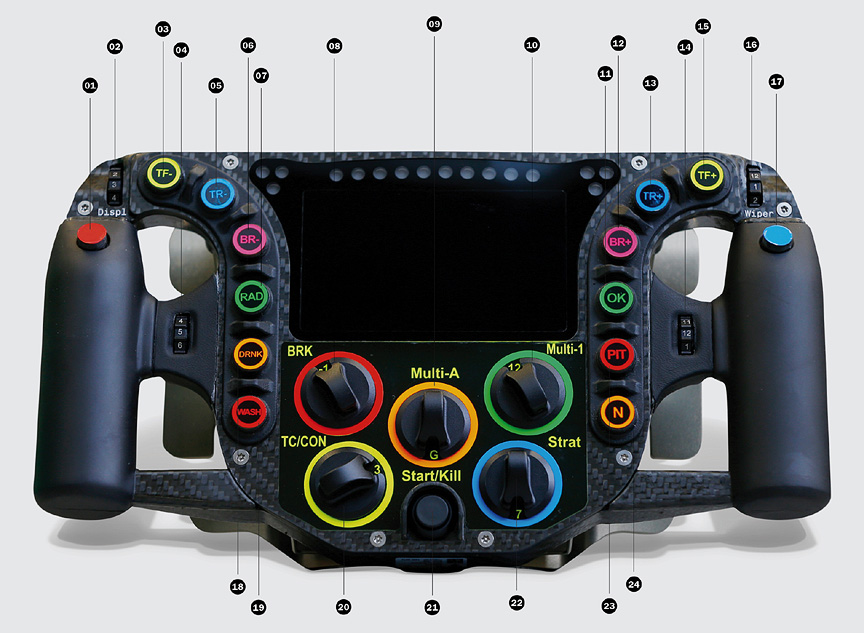
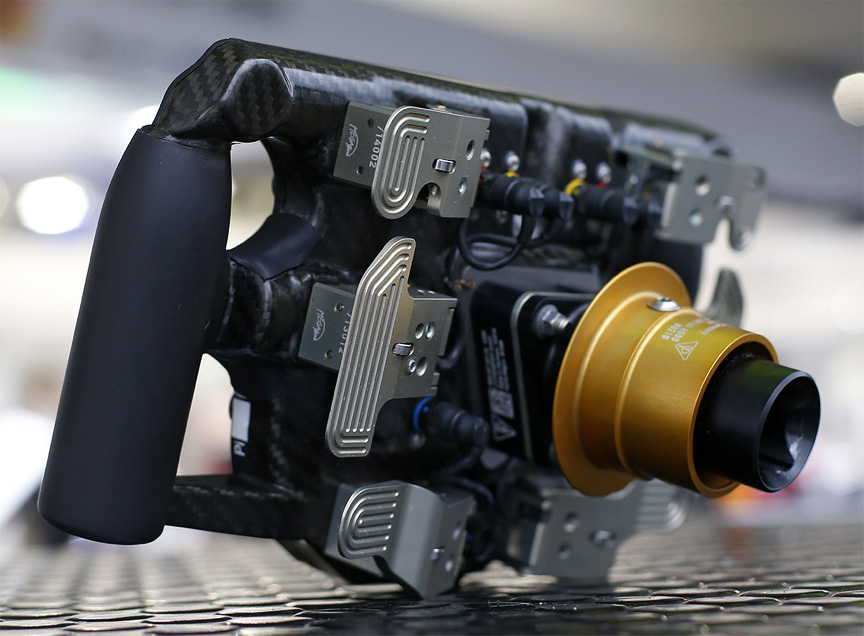
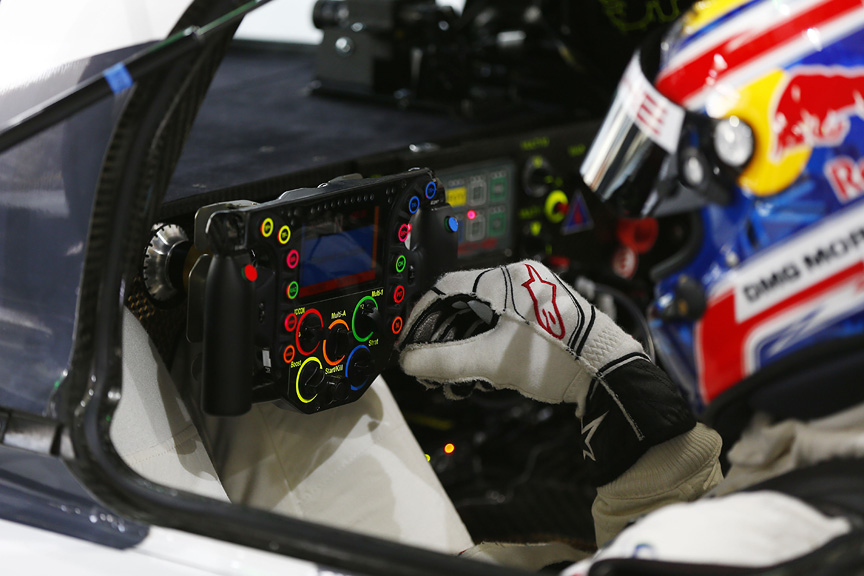
The first race: Silverstone 6 hours 2014
The top class of FIA World Endurance Championship, the LMP1-Hybrid, has a total of six cars from three manufacturers competing. In addition to the Manufacturers’ LMP1-H class there is a LMP1-L private team running two non-hybrid Toyota-powered Lola B12/60. Together with the four Nissan-powered LMP2 cars there are 12 prototype racing cars.
The fastest lap time in the qualification was achieved by an Audi – 1:42.477, but the qualification rules say the average time of two best times of two drivers is taken into account and so the qualification results were as follows:
| 1. | #7 Toyota TS040 Hybrid | 3.7V8 | 1:42,774 |
| 2. | #1 Audi R18 e-tron quattro | 4.0V6 TDI | 1:42,779 |
| 3. | #14 Porsche 919 Hybrid | 2.0V4 Turbo | 1:43,087 |
After the first lap two 919 were 5th and 6th behind the other four LMP1-H cars. One hour to the race, the 919 #14 has problems with suspension/drive train/hydraulics, is repaired at the garage, sent out again, but doesn’t last for long and is out of the race. The #1 Audi crashes and the #2 Audi also later in the race.
Temporarily Timo Bernard manages to put the 919 #20 into second place. The rain becomes heavier and finally there is so much standing water on the track that the race is terminated after 5 hours and 22 minutes. The LMP1-H class is won by #8 Toyota (167 laps, fastest lap 1:44.646), #7 Toyota is second (166 laps, fastest lap 1:44.326) and #20 Porsche 919 is third (165 laps, fastest lap 1:45.245). The fastest race lap goes to #2 Audi with 1:44.217, so Porsche was a full second behind with the speed. In the GT category Porsche takes 1-2 victory with the two 991 RSR. 21 cars were classified as finishers out of 27 starters. Despite the cold weather, the event saw 43.000 spectators.
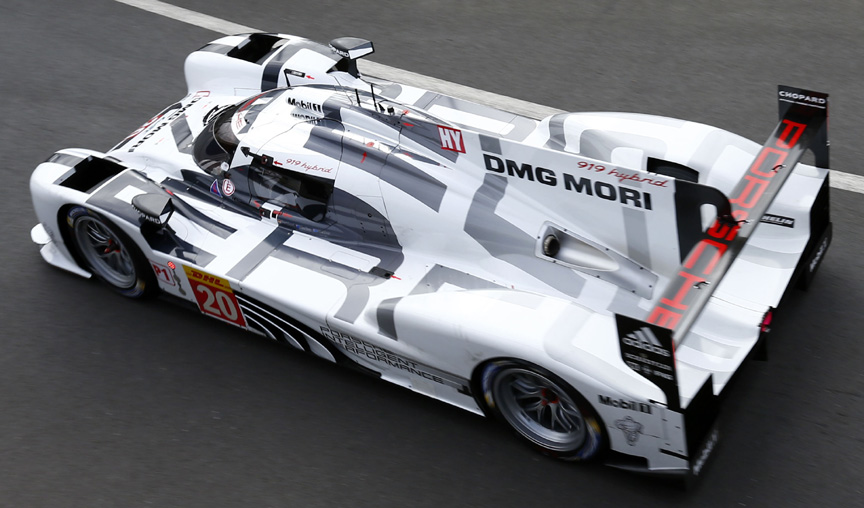
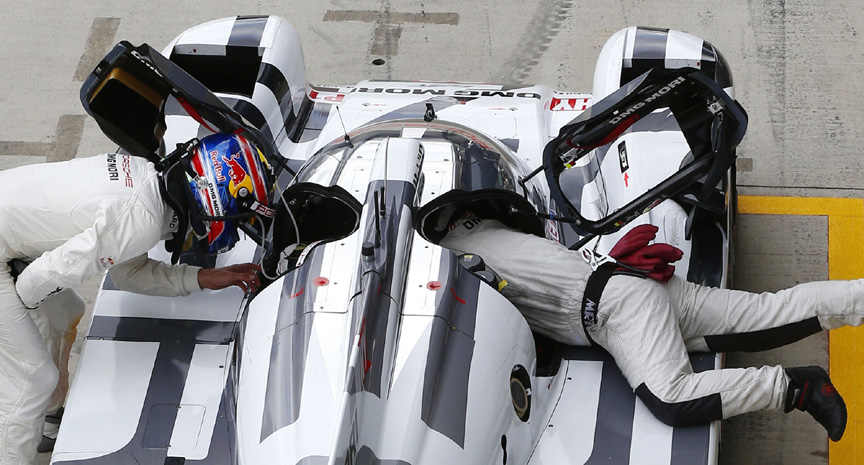
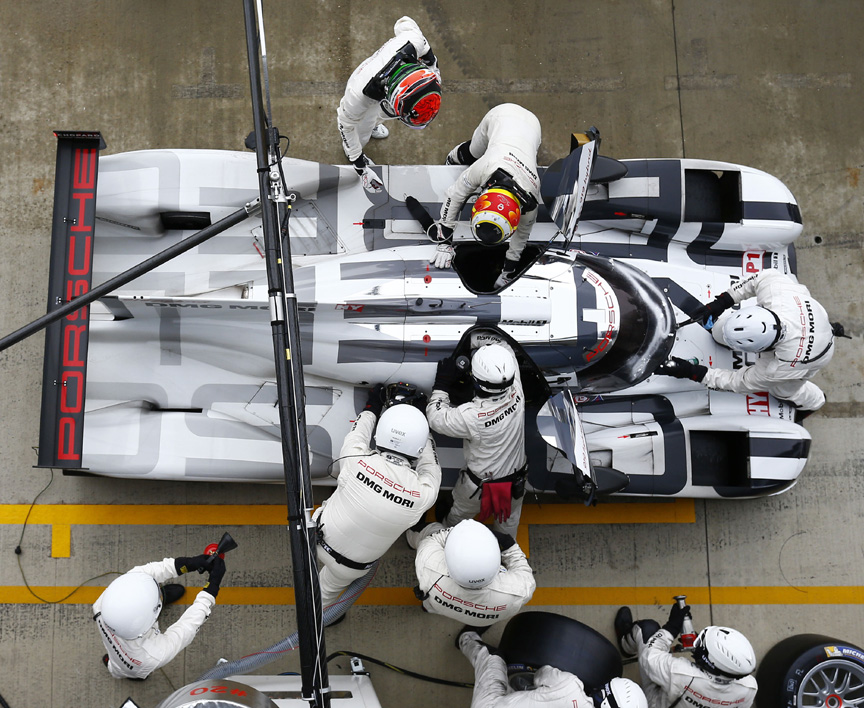
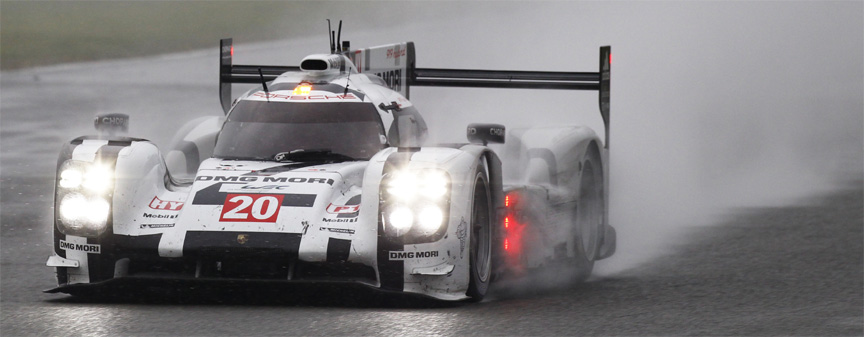
Porsche 919 Evolution
The photos below show the differences between the 2013 prototype and the 2014 racing cars. Differences are not big, but they are everywhere. Different are the wheel arches, mirrors, side air vents, rear body and rear vents to name the most visible features.
Le Mans test, June 1, 2014
The rear bodywork of the 919 changed its shape at high speed which is not in compliance with the rules and Porsche engineers had to fix the issue. The other issue was the fires experienced by both cars on the test day. Alex Hitzinger “We changed the heat shield material around the turbo and we got it wrong, and it started to burn, once it started to burn then everything burns, but we have changed that.”
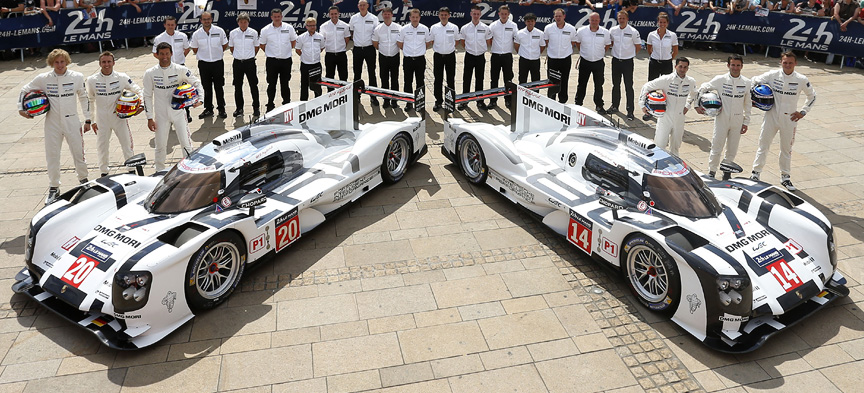
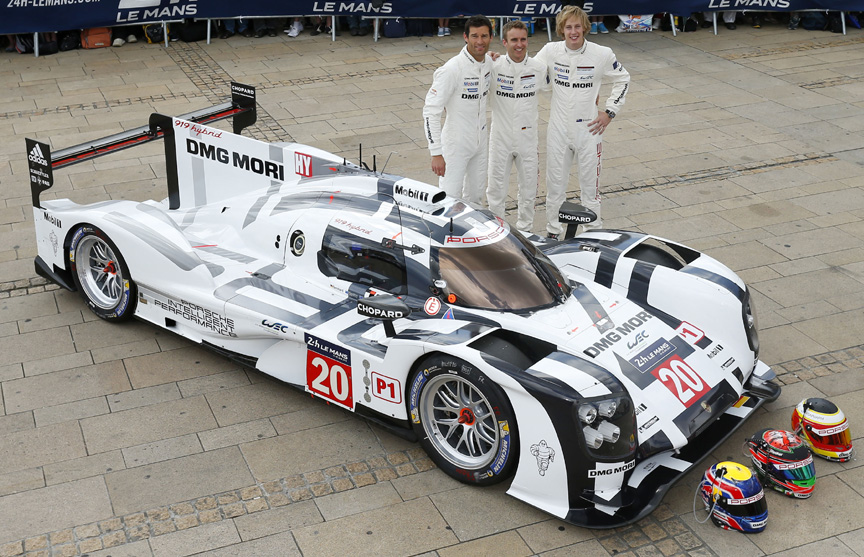
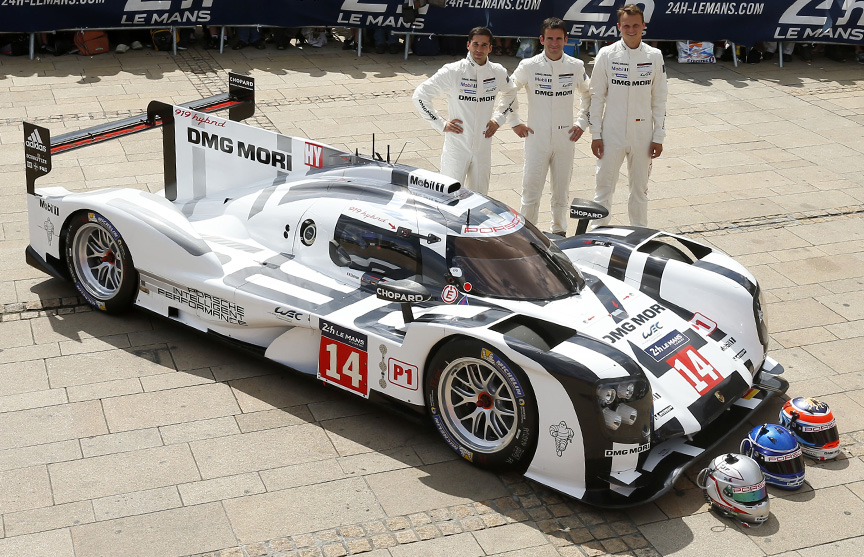
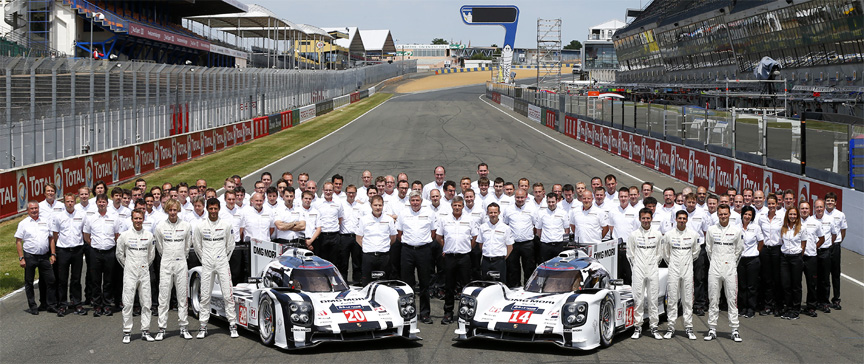
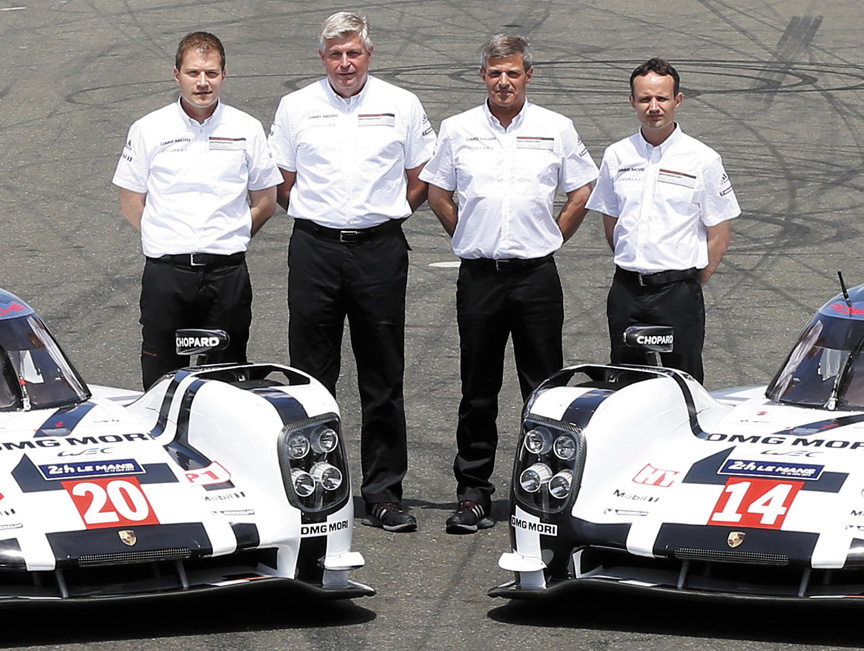
The 2014 Le Mans qualification runs June 11-12
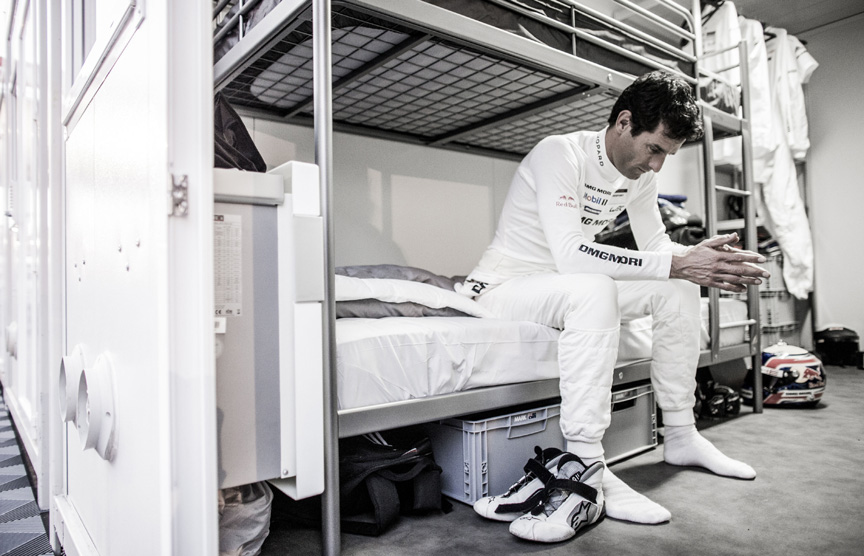

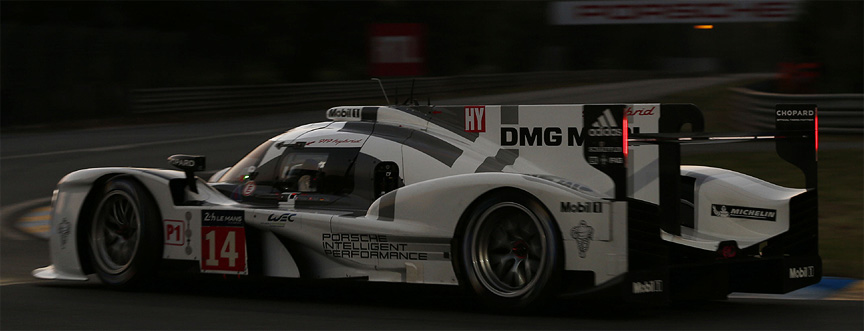
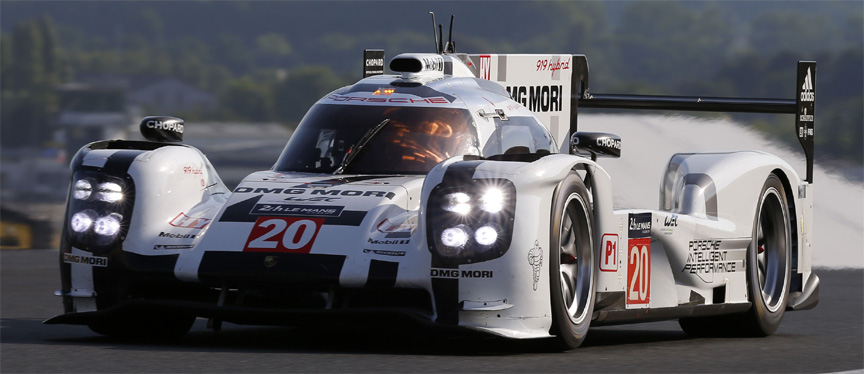
The 2014 Le Mans 24 hour race, June 14-15
Half an hour into the race and the #14 Porsche 919 loses its fuel pressure. It takes 15 minutes in the pits to change the needed parts and #14 drops to 51st position. It starts to rain and at one time a traffic jam develops on the road. A reckless driver of the GT-class Ferrari 458 hits the #3 Audi R18 at the back. More cars are damaged in this accident, including a Toyota #8. Audi #3 is a write-off, while Toyota #8 limps back to garages for a new nose. Three hours into the race Toyota and Audi take their 3rd pit stops and Porsche 919 #20 takes the lead for 7 laps. An hour later, #20 again takes the lead for 9 laps when Toyota goes into pits. Almost five hours into the race Brendon Hartley in Porsche #20 outbraked himself and went through a gap in tires at the first chicane. Luckily, no harm done. Six hours into the race Hartley in #20 is off to gravel at Arnage, but rejoins in a minute.
With almost nine hours into the race Neel Jani in Porsche #14 goes briefly off at Arnage. A factory team Porsche 911 991 RSR #91 also develops fuel pressure problems and starts to visit the box – first for 40 minutes, then for 20 minutes and then for 30 minutes.
At the half race (3 am) the #14 Porsche 919 gets a new door on right side (probably a hinge or lock problem). Just a few laps later #14 is having technical problems again and is limping back to pits. It is suffering from the same problem like in the beginning of the race – low fuel pressure. It takes 15 minutes to fix the car.
In the morning at about five o’clock the leading Toyota #7 suffers from electrical problems and has to retire after otherwise problem-free race. #7 started to lead the race already seven o’clock last evening. All LMP1-H cars are having technical problems and the #7 Toyota was the strongest until it suddenly got unrepairably ill. Audi R18 e-tron #2 takes the lead. #20 Porsche is 3 laps behind. At six o’clock in the morning Marc Lieb in #14 Porsche goes off at Indy and is stuck on the gravel. He is being helped out by marchals and is moving again in a few minutes. The #20 Porsche piloted by Mark Webber is going third after two Audis. At seven in the morning the leading Audi #2 develops problems and is repaired for about 20 minutes. The #1 Audi takes the lead. Tom “Mr. Le Mans” Kristensen’s team is finally in the lead. He has 9 Le Mans victories already and is missing the 10th. Everything looks superb. Webber in Porsche #20 is on second place. At 11 o’clock Kristensen is having problems with his car and even stops briefly at the track. He limps to pits. Timo Bernhard in the Porsche #20 takes the lead. Audi #1 returns after 17 minutes in the pits. Lotterer in #2 Audi is lapping roughly 5 seconds faster than Bernhard in #20 Porsche. At 1 pm Webber loses the internal combustion engine of his #20 Porsche. The front axle electric motor helps him to limp to pits. The race is over for #20. As Webber put it: “When I was driving in second with only two more hours to go and heard that bang from the powertrain, I knew this was the sound of the end of a dream”. Audi #2 is now leading, Audi #1 going second and Toyota #8 now third – from last place after accident! Porsche #14 has problems with gearbox and comes into pits from now 4th place.
The three remaining LMP1-H cars have more than an hour to go. Nothing changes and the race is won by Audi #2, followed by Audi #1 and Toyota #8.
Change of leaders:
| June 14, 15:03 | Toyota TS040 hybrid #7 | 35 laps |
| June 14, 17:50 | Porsche 919 hybrid #20 | 7 laps |
| June 14, 18:17 | Toyota TS040 hybrid #7 | 3 laps |
| June 14, 18:30 | Porsche 919 hybrid #20 | 9 laps |
| June 14, 19:01 | Toyota TS040 hybrid #7 | 164 laps (202 laps in total) |
| June 15, 04:59 | Audi R18 e-tron #2 | 33 laps |
| June 15, 07:07 | Audi R18 e-tron #1 | 65 laps (65 laps in total) |
| June 15, 11:20 | Porsche 919 hybrid #20 | 22 laps (38 laps in total) |
| June 15, 12:36 | Audi R18 e-tron #2 | 41 laps (74 laps in total) |
LMP1-Hybrid qualification results versus best lap in race:
| Qualification | Best race lap | |
| Toyota TS040 hybrid #7 | 3:21,789 (1.) | 3:23,112 (2.) |
| Porsche 919 hybrid #14 | 3:22,146 (2.) | 3:24,899 (6.) |
| Toyota TS040 hybrid #8 | 3:22,523 (3.) | 3:23,117 (3.) |
| Porsche 919 hybrid #20 | 3:22,908 (4.) | 3:25,532 (7.) |
| Audi R18 e-tron #3 | 3:23,271 (5.) | 3:24,274 (4.) |
| Audi R18 e-tron #2 | 3:24,276 (6.) | 3:22,567 (1,) |
| Audi R18 e-tron #1 | 3:25,814 (7.) | 3:24,393 (5.) |
First victory for the 919 and a huge crash for Webber – the 2014 WEC 6 hour race in Brazil
At the last race of the 2014 FIA WEC season, Porsche finally managed to take its first victory in the LMP1 category. The #20 919 had started the race from the pole position and led for about 2 hours until suffered from some power loss from the engine and started to drop back. The #20 car was running, but didn’t have chances for the podium anymore. With only half an hour to the end of the 6 hour race, Mark Webber unfortunately crashed the #20 car. The race was won by Porsche #14 piloted by Romain Dumas, Neel Jani and Marc Lieb.
LMP1 results 6 hours of São Paulo:
| 1. Dumas/Jani/Lieb | Porsche 919 Hybrid | 249 laps |
| 2. Davidson/Buemi | Toyota TS040 Hybrid | 0,170 s |
| 3. Di Grassi/Duval/Kristensen | Audi R18 e-tron quattro | 1 Lap |
| 4. Wurz/Sarrazin/Conway | Toyota TS040 Hybrid | 1 Lap |
| 5. Fässler/Lotterer/Tréluyer | Audi R18 e-tron quattro | 1 Lap |
Drivers comments:
Romain Dumas (#14): “It is great we have won that race for Porsche, but, of course, it was a lot more important to know that Mark was okay. My first stint today ended early due to a right rear puncture. I don’t know what caused it, but maybe some debris. When I was back in the car later in the race I had a much better time. The grip level of the track had improved and we had changed the tyre pressure in the rear. The car was really good.
Neel Jani (#14): “This was a tough race – every lap in qualifying mode and good battles with the number 8 Toyota. That it worked out in the end is almost unbelievable. Together with Romain and Marc we achieved the first pole position for the 919 Hybrid and now the first win. To me this was a dream season. The next dream would be to win the World Championship and to take Le Mans. We hope this is what the future brings. We are now even third in the drivers’ championship – who would have believed that?
Marc Lieb (#14): ”What a day for our team! On lap one I lost one position to a Toyota, he surprised me with boosting in a corner, as I wasn’t expecting it. Afterwards it was impossible for me to get past him, although I had the faster car. I tried everything but he was all over the place. The second time in the car my biggest problem was tyre pick-up in traffic as soon as I had to leave the racing line. It was like driving on ice.”
Timo Bernhard (#20): “I had a very straight forward first stint with leading the race from the start until our first pit stop. I handed over the car to Mark Webber with a 12 second lead. Managing the traffic was really challenging, especially towards the end of my stint when I had some bad luck with slower cars. The heat was also really tough. My second stint later in the race wasn’t as satisfying, because by then our car didn’t have its full power anymore. However, this isn’t important anymore. All what counts is that Mark is okay.”
Brendon Hartley (#20): “This was an emotional rollercoaster with the most important news being that Mark is alright. The beginning of my first stint was great when I was leading the race. Timo and Mark had done a great job to bring our car to where it was and it felt fantastic. Then, about ten laps into my stint unfortunately we lost some engine power. We could not defend our position and dropped back. But at least we could have finished the race and it was great to drive on this track. However, this is overshadowed after Mark’s accident.”
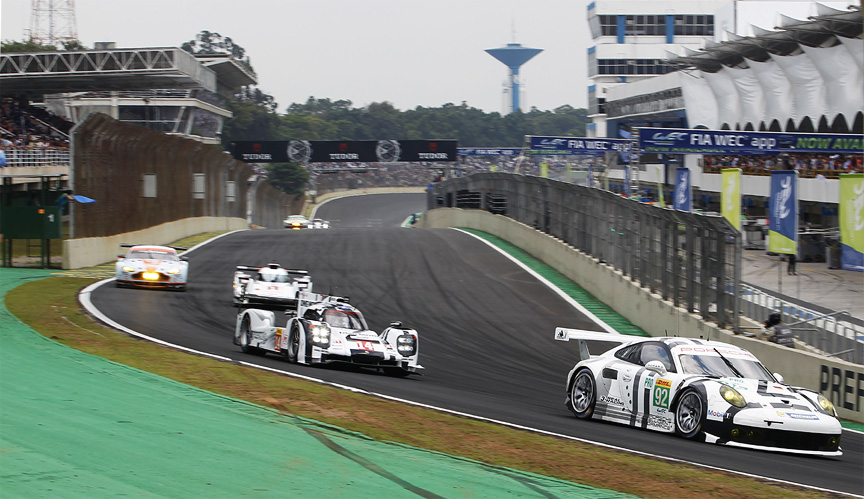
2014 FIA WEC LMP1 manufacturers’ results
| 1. Toyota | 289 points |
| 2. Audi | 244 points |
| 3. Porsche | 193 points |
